Stay in the Loop
Subscribe for exclusive content, giveaways, new products and more!

- Backpacking
- Backcountry Cooking
- Wilderness Medicine
- Destinations
- TRIP REPORTS

Canoe Camping Meals: 10 Easy Canoe Trip Recipes
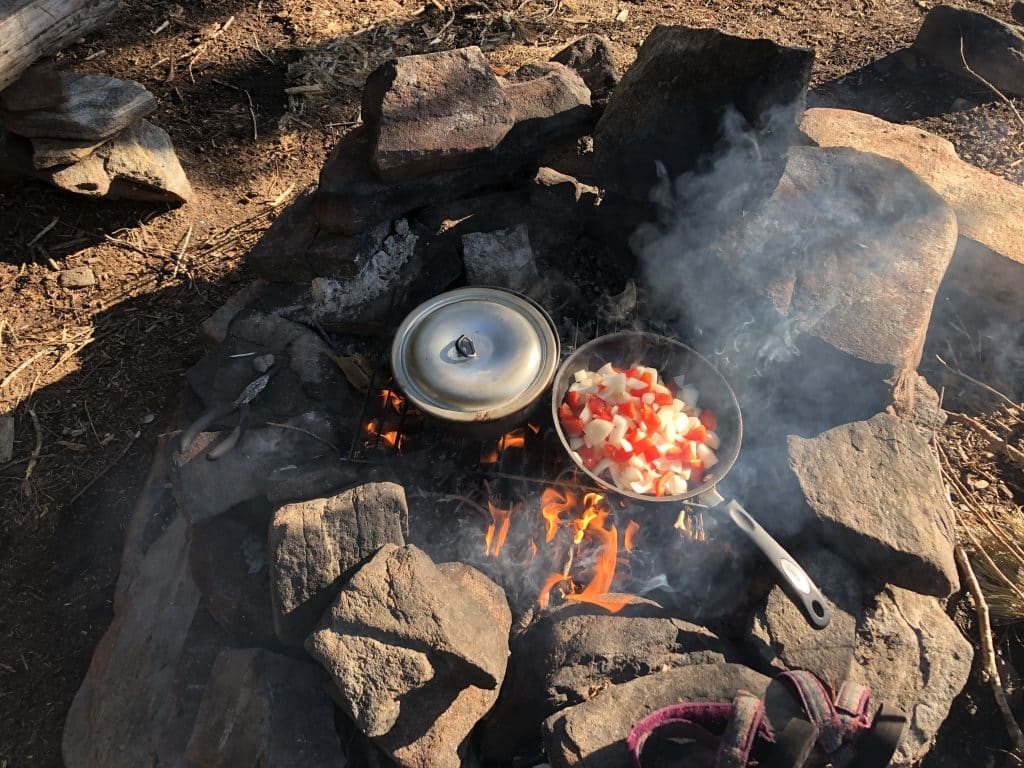
After a long day of paddling and portaging, there are few things better than starting a fire and cooking up a nice warm meal. Backcountry cooking is one of my favourite parts of a canoe trip, so I love any opportunity to experience backcountry-adapted gourmet canoe trip meals.
In this post, you’ll find 10 canoe camping recipes to try on your next trip.
For more canoe trip recipes (and a comprehensive guide on how to build the perfect canoe trip menu) check out my eCookbook: The Voyageur’s Backcountry Cookbook .
Canoe Trip Breakfast Ideas
1. breakfast sandwiches.
Another great choice is breakfast sandwiches. If it’s early in the trip, you can bring English muffins. If you want to have this meal later into the trip, you can use wraps, powdered egg and bacon bits or sausage.
Ingredients : wraps or English muffins, powdered eggs, powdered milk, bacon or sausage, ketchup packets, cheese optional: avocado, tomato
Instructions :
- Mix powdered eggs and powdered milk at a 6-to-1 ratio and mix with water until thick and runny. Scramble the eggs.
- If needed, cook the bacon and toast the english muffins.
- Add scrambled eggs, bacon and cheese to english muffin or wrap. Add toppings and ketchup and close.
- Optional: Wrap in tin fold and heat over the fire to keep them warm and toasty while you wait for your coffee to brew.
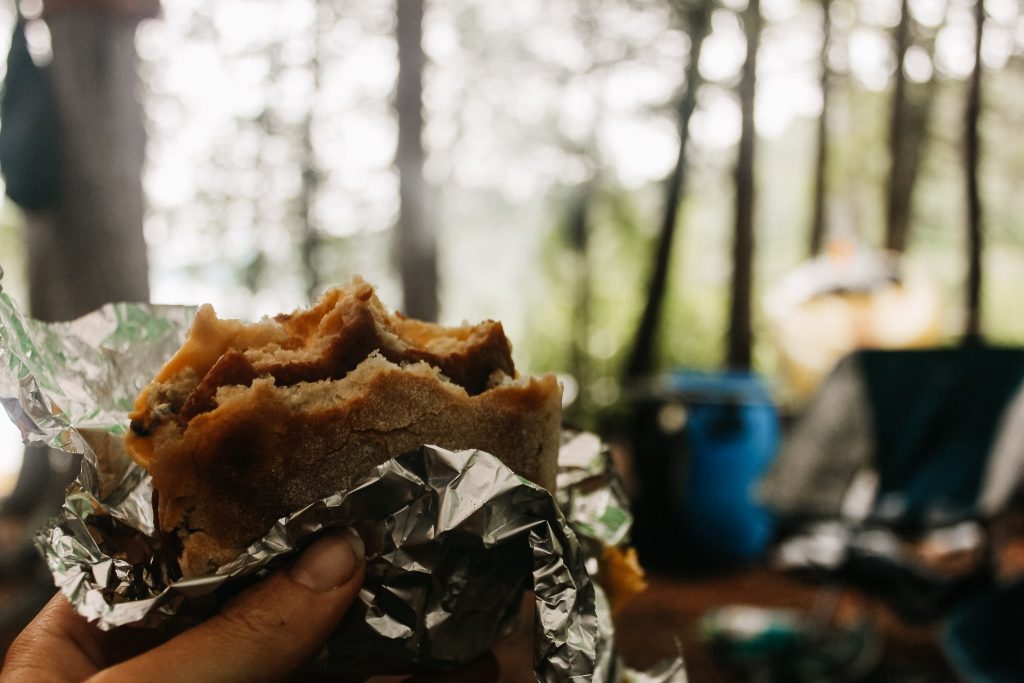
This post may contain affiliate links. If you make a purchase through one of these links, I may receive a small commission at no extra cost to you. Your support is much appreciated! You can learn more by reading my full disclosure .
2. Cinnamon Buns
Another classic for a rest day is cinnamon buns. They require a Dutch oven and some prep work, and you’ll want to make sure you pack some butter dedicated for this meal because it needs a lot of butter.
Ingredients : baking mix*, flour, brown sugar, cinnamon, butter, optional: nuts, raisins, powdered sugar
- Add equal parts flour and baking mix into a bowl with a little cinnamon; gradually add water and stir. You want a ball of dough that holds, but you don’t want it too sticky.
- On a cutting board with a little flour, roll out the dough so it’s flat and in an oval.
- Spread butter over the surface of the dough, then add a generous amount of brown sugar. Sprinkle cinnamon and nuts / raisins.
- Roll it lengthwise so it looks like a tube. Then, slice the tube so you have a bunch of little cylinders.
- Butter the inside of the Dutch oven. Be generous! Then put your cinnamon rolls (cylinders) into the Dutch oven. Place on the embers of the fire and wait. They will probably need ~20 minutes, but check regularly.
- Once crispy brown, remove and sprinkle some powdered sugar on top.
Tip : To make baking mix, combine 4 cups of flour, 2.5 tbsp of baking powder, 1/4 cup milk powder and 2 tsp of salt in a bag.
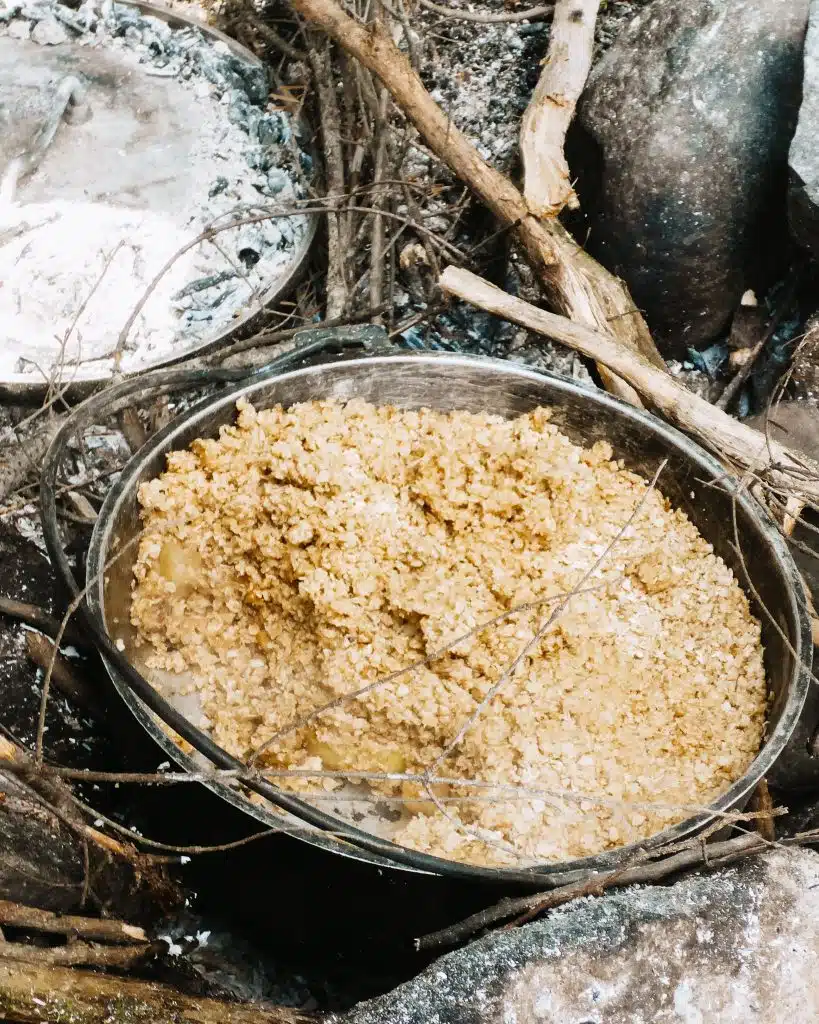
Bonus: Oatmeal
Oatmeal is my go-to backcountry camping meal because it’s so easy to make and clean up. Plus, there are a ton of ways to make oatmeal more interesting.
Here are two of my favourite recipes for oatmeal, and I have six other recipes in this blog post.
Sweet & Savoury Oatmeal
This recipe is met with mixed reviews. Cut leftover bacon into small pieces (or you could try packaged bacon bits) and top the oatmeal with shredded cheddar cheese and diced apples . A little nutmeg and brown sugar bring this bowl to life. As I said, this sweet & savoury bowl gets varied feedback – bacon in oatmeal?!? But hey, don’t knock it til you try it. I’m a huge fan now, myself.
Maple Oatmeal
Maple syrup in oatmeal – a Canadian classic, eh? Instead of brown sugar, sweeten this bowl with maple syrup , adding toppings like craisins and coconut to create texture. If you’ve got a fresh banana , a few slices go great with the maple.
Read More : 8 Recipes to Make ~Not Boring~ Oatmeal on Camping Trips
Tip : Don’t make the oatmeal in the pot! Instead, boil water in the pot and put quick oats in everyone’s bowl. Let each person add the amount of hot water they need to get their oatmeal to the desired consistency. I personally, like my oatmeal very dry and hate it when someone makes a single batch. This also makes cleaning up easier because you don’t have to wash a pot.
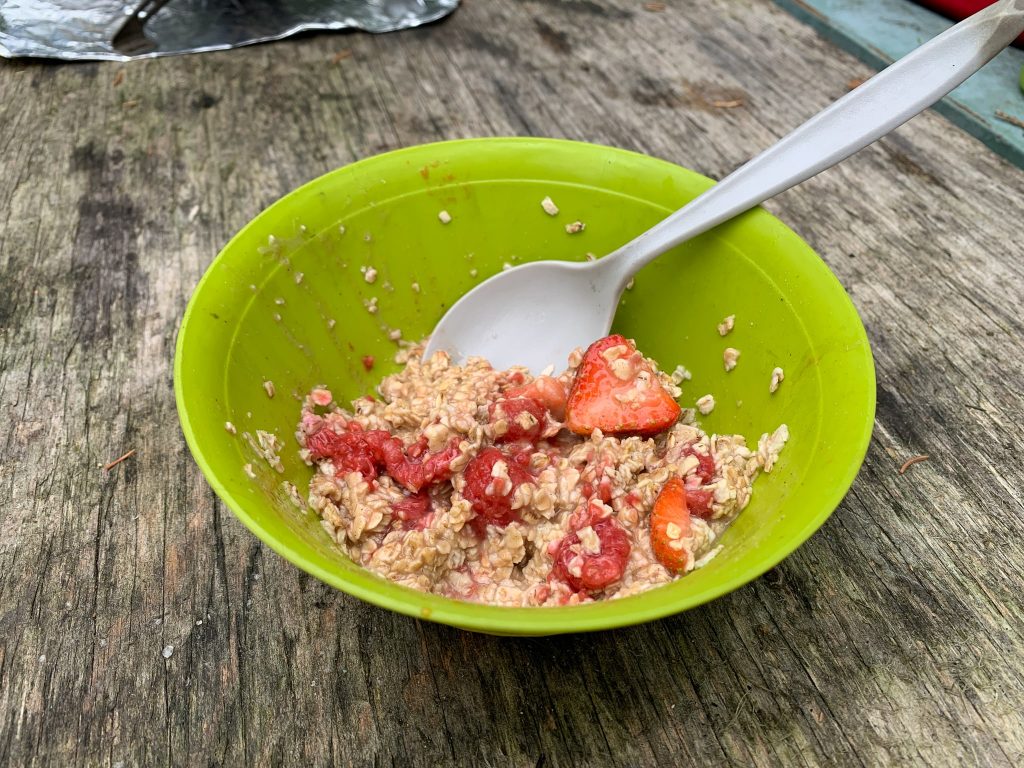
Canoe Trip Lunch Ideas
I typically eat a lot of wraps for lunch on canoe trips. They’re easy to pack, quick to make and there’s a decent amount of variety you can get with fillings.
3. Burrito Wraps
Burritos are a crowd-pleaser. They require some work the night before but are worth the effort. You can also cook rice and add it to the burrito to make it even more filling. This is also a great opportunity to use sriracha or other hot sauce.
Ingredients : wraps, cheese, onion, peppers, tomato sauce, refried beans
- The night before: If needed, rehydrate refried beans, tomato sauce and veggies by adding them to a saucepan or pot with a small amount of clean water. Stir regularly, adding more water as it is absorbed.
- Once everything is rehydrated, let it cool and then store it in a Nalgene or bag.
- Day of: Spread bean mixture in the centre of the wrap and add cheese. (Don’t use cheese if vegan).
- Fold into a burrito. You can heat the burrito over a stove if you’d like.
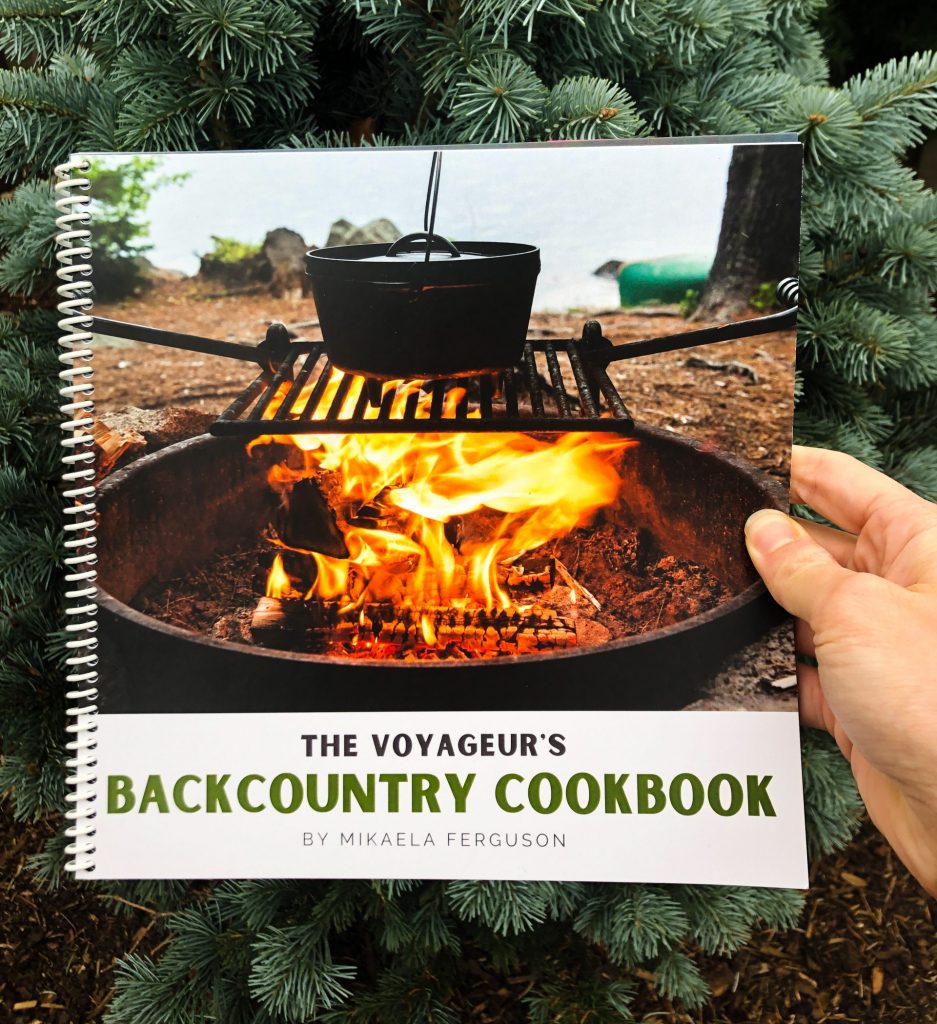
4. Hummus Buddha Bowls
This is a high-protein, high-nutrient lunch that you can make reasonably quickly. The only downside is that it does require a dish and utensil. But other than that, this is an easy canoe trip lunch idea!
Ingredients : Cooked quinoa, dehydrated hummus (you can purchase dried hummus or dehydrate your own ), nuts / seeds (I like pine nuts or crushed walnuts), spices, Flax Crackers and / or Vegetable Chips (see below for making your own).
DIY Veggie Chips : Thinly slice easily chip-able vegetables (i.e. sweet potatoes, zucchini, beet, carrot). Toss vegetables in a tiny bit of olive oil and salt. Place on parchment paper-lined baking sheet. Cook on low heat (max 200 F) for at least 45 minutes.
- Pack the dehydrated hummus with the spices and nuts / seeds.
- Cook the quinoa the night before and store it in a plastic bag or sealed container.
- Rehydrate hummus in a bowl by slowly adding water and stirring. You’ll probably need about 1/4 cup of water, but you’ll know you’ve added enough when it’s reached your desired consistency. You can also add a small splash of olive oil, which will give the hummus a nicer texture, but I’m usually too lazy for that.
- Mix the quinoa with the hummus and nuts / seeds.
- Scoop the hummus mixture with your crackers and veggie chips and enjoy!
Note : Most people prefer this without the cup of quinoa, but I just don’t find this meal filling enough without the added grain.
Bonus : Sprinkle some dried kale on top for extra nutrients and additional crunch!
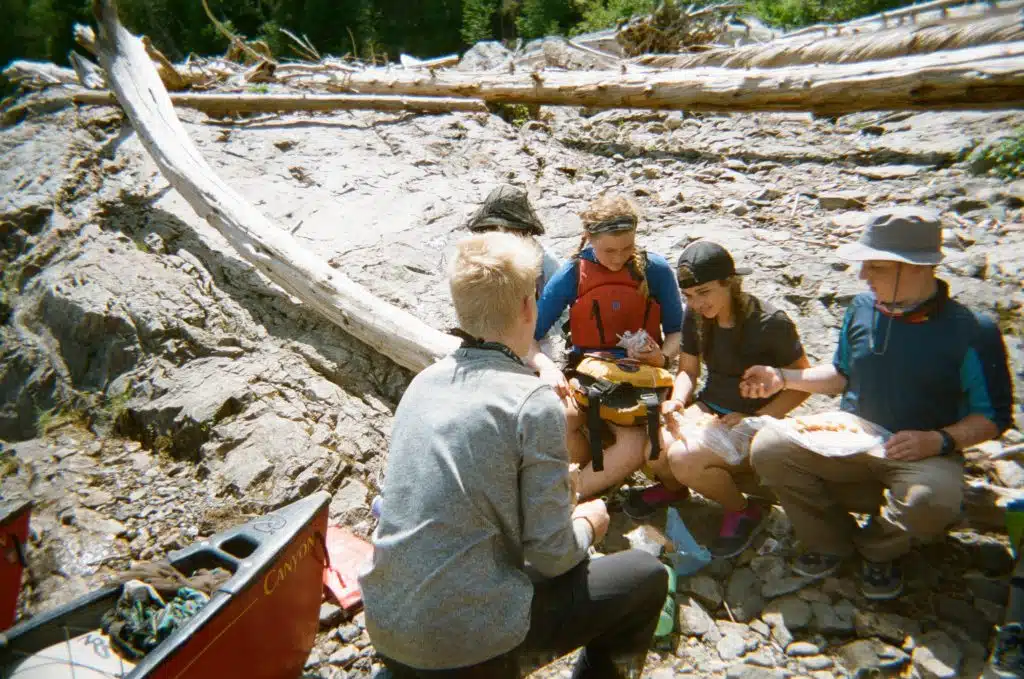
Canoe Trip Dinner Ideas
5. chilli & garlic bread.
This is my favourite camp meal. This is a meal best prepared by two or more people (someone to do the garlic bread and another to do the chilli).
Ingredients :
dehydrated ground beef or textured vegetable protein (TVP), dehydrated beans, dehydrated veggies, dehydrated tomato sauce, spices and bread mixture
- Make the garlic bread according to the instructions on page 42. Make chilli according to the instructions below:
- Add a splash of clean water to the pot and some dehydrated tomato sauce. Stir regularly. As the sauce absorbs water, add a little more.
- Once the sauce is almost rehydrated, add in the vegetables, and ground beef or TVP and big handfuls of dehydrated beans. Continue stirring and adding water if necessary. Add spices.
- Stir regularly. If the chilli looks too thick, add water. If the chilli looks too watery, add either more TVP or put a small handful of potato pearls.
- Let simmer on low heat.
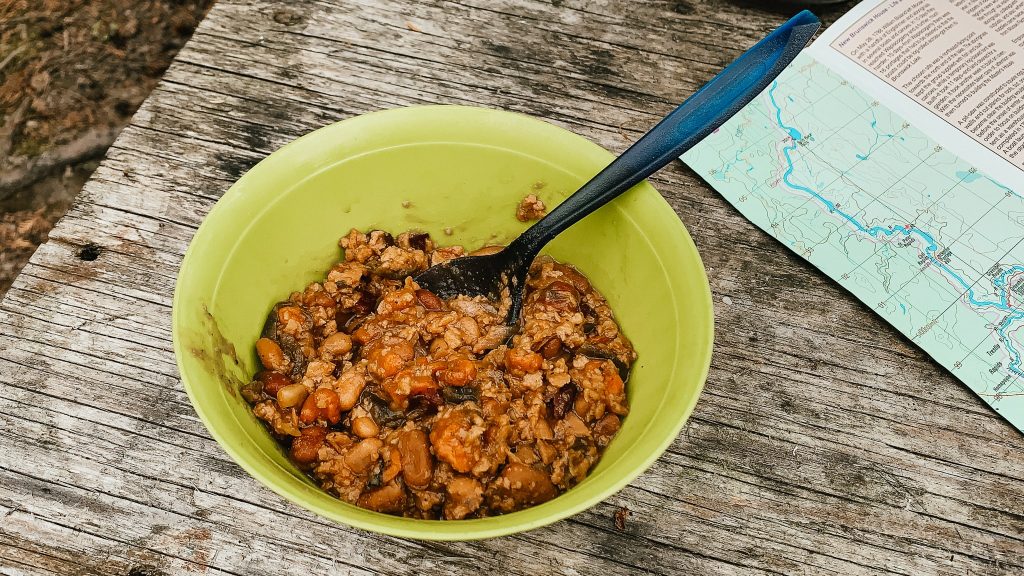
6. Thai Red Curry
This is a super easy but super delicious meal to make. It’s so easy because most of the flavour comes from the red curry paste. You don’t need to refrigerate the paste before you open it, so I’ll buy a few small jars.
Ingredients : rice, coconut milk, jar of red curry paste, cayenne pepper, onion, peppers, mushrooms, zucchini, chickpeas.
- Boil water in a pot. Pour in rice and stir. Go with a water-to-rice ratio of 2:1.
- In a frying pan, rehydrate veggies and chickpeas if necessary. Pour in a can of coconut milk. Add some red curry paste and a pinch of cayenne pepper.
- Once rice is cooked and the sauce is done, scoop rice into bowls and add a big spoonful of sauce onto the rice.
- You can garnish with cilantro and peanuts if you’d like.
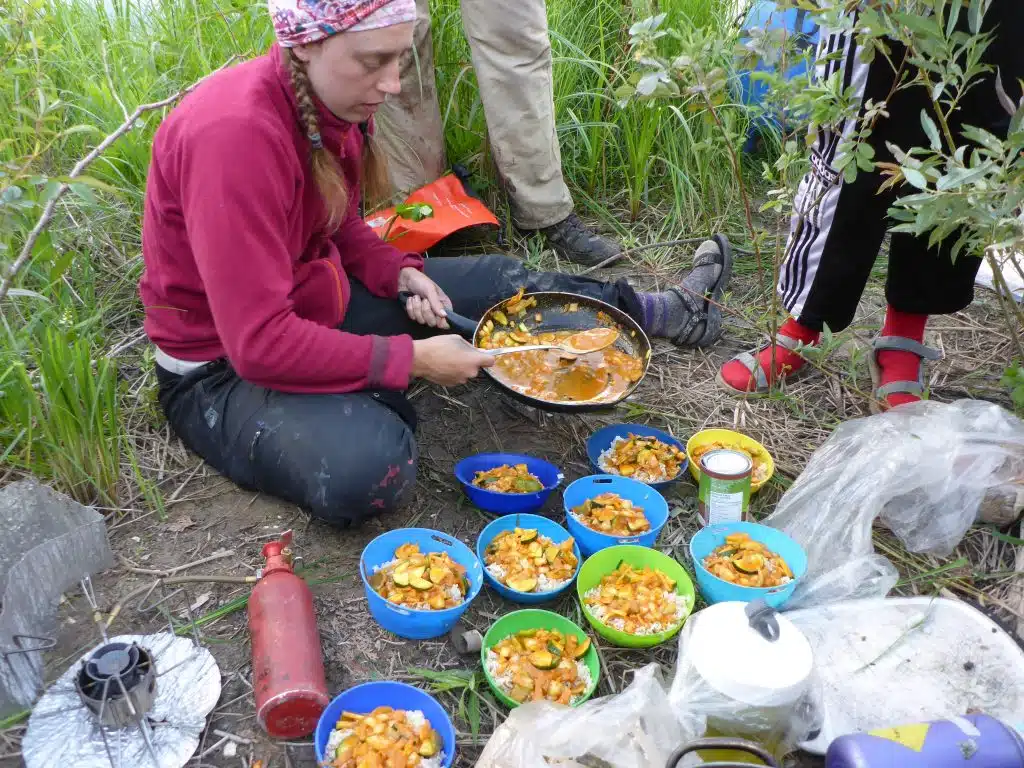
Canoe Trips Snacks
7. protein-based snacks.
So much of the food on canoe trips – especially the snacks – is carb-based. This is great for quick energy, but sometimes you need something with more fat and protein to sustain you on those long days.
Dates + Cheese + Pepperoni
This may seem like a weird combo, but it works out to be the perfect salty-sweet snack. Stack a date on a small slice of cheese and wrap in pepperoni. It’s actually very tasty.
This is a tasty, yet filling snack option. You can buy beef jerky in bulk or make your own and eat it after a long portage. The salt will be good after a long period of sweating!
Pepperoni Sticks
Similar to the above, pepperoni sticks are a filling afternoon snack. And if you want to experiment, use those individual packets of cream cheese as a dip. Personally, I love it.
Tuna on Crackers
Another high protein option, you can bring tuna canned or in individual packets (you can even get different flavours). Scoop onto crackers and enjoy!
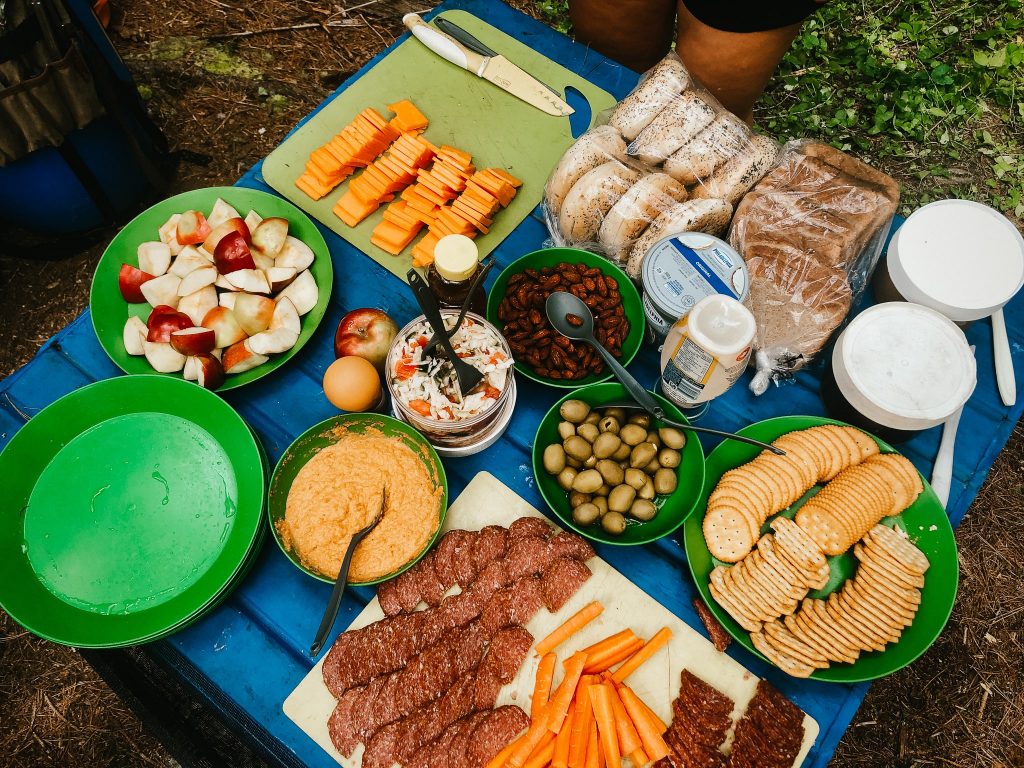
8. Homemade Fruit Leather
Rather than buying (expensive) store-bought fruit leather, you can easily make your own at home in either a dehydrator or in your oven. Below I’ve outlined the steps that I take to create fruit leather at home.
If you don’t want to make your own, this is my favourite store-bought fruit leather. My only issue with it is that I need two to feel satisfied and they’re pricey – definitely buy in bulk rather than from the grocery store!
Note that I do all my dehydrating in an oven, rather than a dehydrator. If you have a proper dehydrator at home you can still follow this process but you may need to adapt a few steps for your specific dehydrator.
Ingredients : Apple sauce, optional: cinnamon, nutmeg, shredded coconut, chopped nuts.
- Preheat your oven to the lowest temperature setting it has.
- Line a baking sheet with parchment paper. Do not use wax paper!
- In a big bowl, pour in a can of apple sauce.
- This is the creative part: mix in any additional toppings / fillings that when make your fruit leather more fun. I always add cinnamon and nutmeg; I’ve also experimented with shredded coconut. I think chopped nuts could also be really tasty, though I’ve never tried that myself.
- Use a spatula to pour your mixture onto the parchment paper and spread until it’s a consistent thickness across the sheet, no more than 1/2 inch thick.
- Place in the oven.
- Cook time will depend on the thickness of your spread apple sauce and your oven’s lowest temperature, but I’ve found it to take about 6-7 hours in my oven.
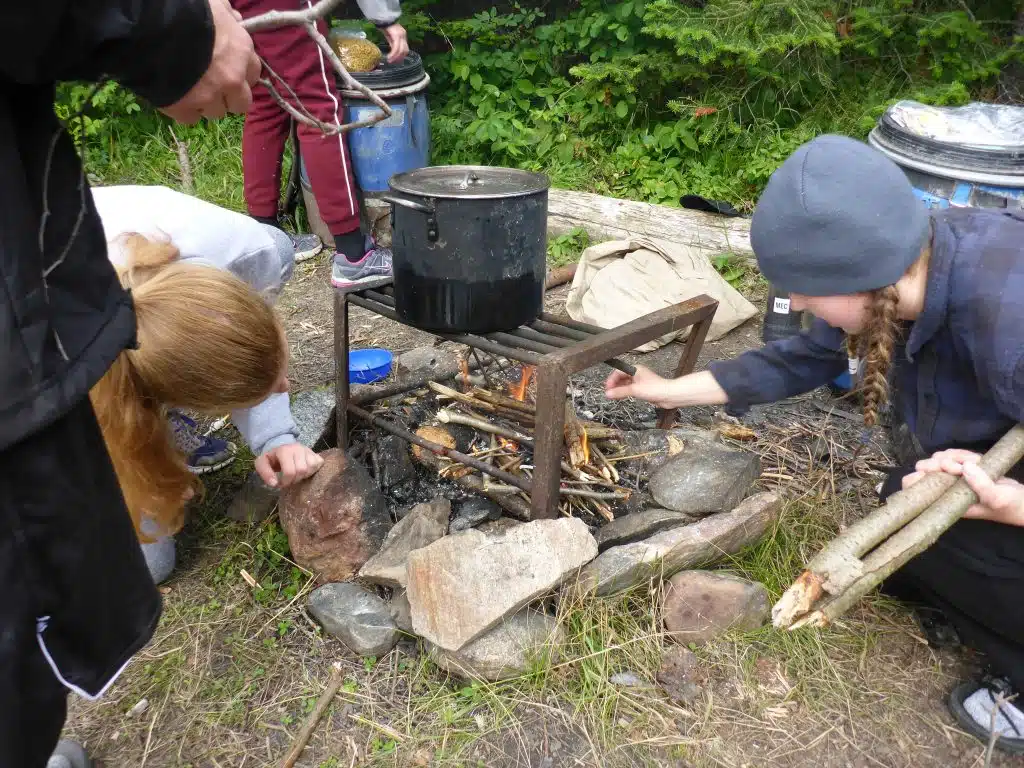
Canoe Trip Desserts
9. lazy cheesecake.
This is such a lazy dessert I’m almost embarrassed to include it, but it’s so tasty. And it’s an awesome dessert if you are camping somewhere that has wild blueberries!
Ingredients : cheesecake powder, graham crackers, chocolate chips or fresh or dried blueberries
- In your bowl, add a few spoonfuls of cheesecake powder. Add clean water slowly, stirring until it is a thick liquid.
- Crush graham crackers over your bowl and add either chocolate chips or fresh blueberries. Enjoy!
Note : You could also make this un-lazy, by making a graham cracker crust and cooking it in a Dutch oven (page 63 of my cookbook).
10. Chocolate Cake
This is what I try to prepare whenever there is a birthday on trip. I discovered it on MyCCR a while back and fell in love. I use a Dutch oven, but if you have Reflector Oven and cake pan you can use that instead.
Ingredients : chocolate cake mix, instant chocolate pudding, milk powder, egg powder, water, butter, flour, chocolate chips, icing sugar.
- Mix 1/2 box of cake mix with 1/2 package of instant pudding mix, 1/2 cup of milk powder and 1/4 cup egg powder (you can put this all in a plastic bag at home).
- Grease a Dutch oven with butter. Sprinkle a little flour on the butter (this helps with sticking).
- Pour the dry ingredients and 1 cup of water in the Dutch oven and stir. If the mixture is really thick, add a little more water.
- Cover Dutch oven and place in the embers of the fire.
- After 30 minutes, check on the cake. Stick a fork in the middle – fork should come out dry if the cake is done.
- When done, use a knife to separate the cake from the oven along the edges. The cake may come out with the knife, or try flipping the oven upside down and over a plate or cutting board, and giving it a little shake. The cake should fall out (flip the cake over so it’s right side up).
- Finally, sprinkle some icing sugar on top, cut and serve! You can also bring shelf-stable icing to spread on top.
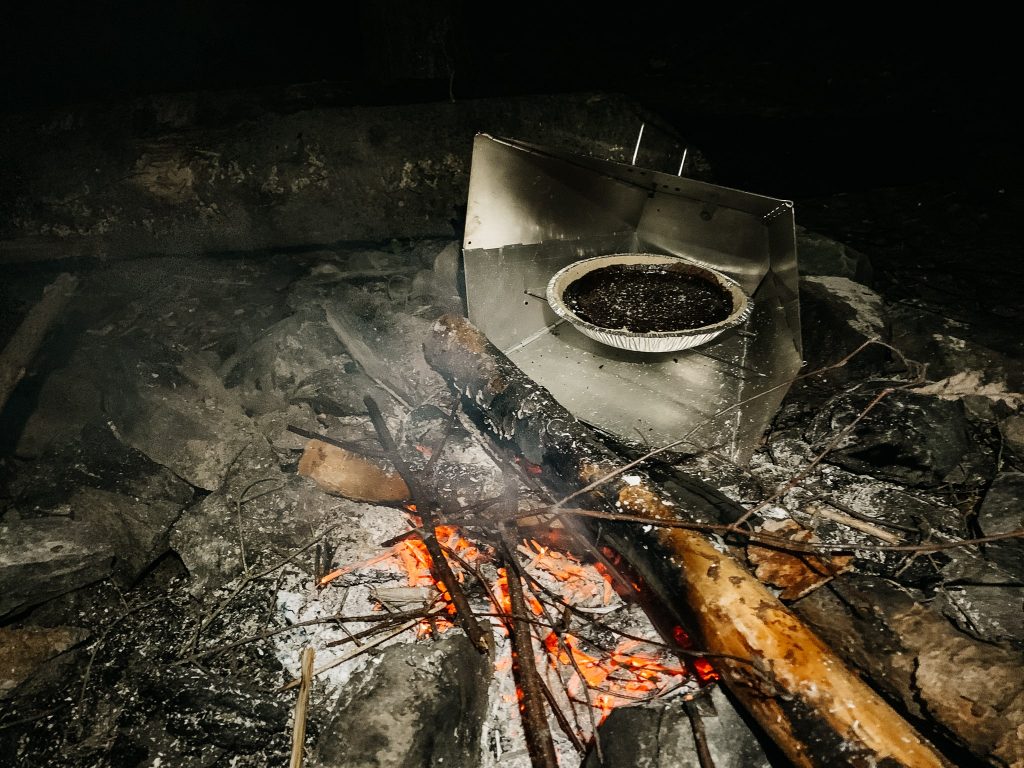
Canoe Trip Recipes – Final Thoughts
If you need more inspiration for creating excellent canoe trip meals, consider checking out The Voyageur’s Backcountry Cookbook . It has a ton of canoe trip food ideas, plus tips for meal planning, food preparation, dehydration and more.

Mikaela | Voyageur Tripper
Mikaela has been canoeing, hiking and camping for over ten years. She previously worked as a canoeing guide in Canada, and spent a season guiding hiking and kayaking tours in the high Arctic. Mikaela is a Wilderness First Responder and Whitewater Rescue Technician.
MY FAVOURITE GEAR
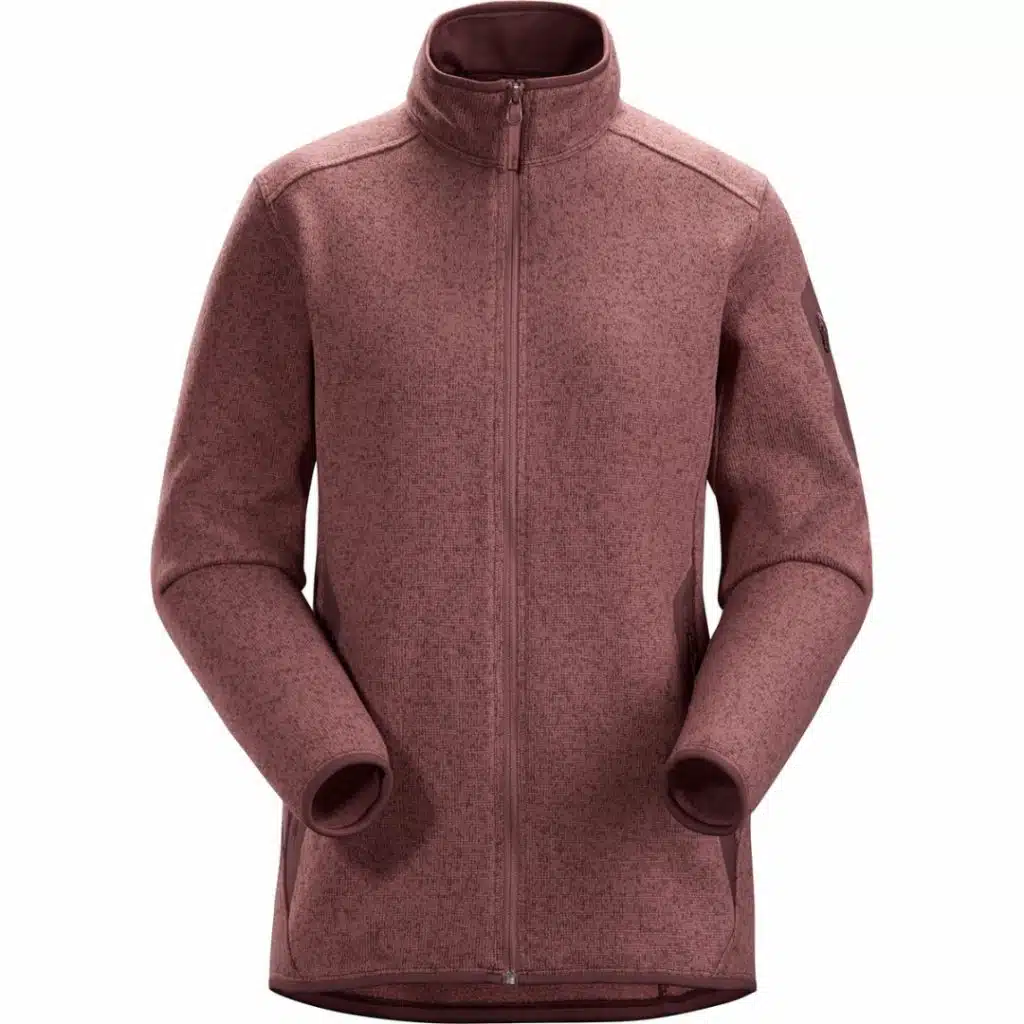
Fleece Sweater
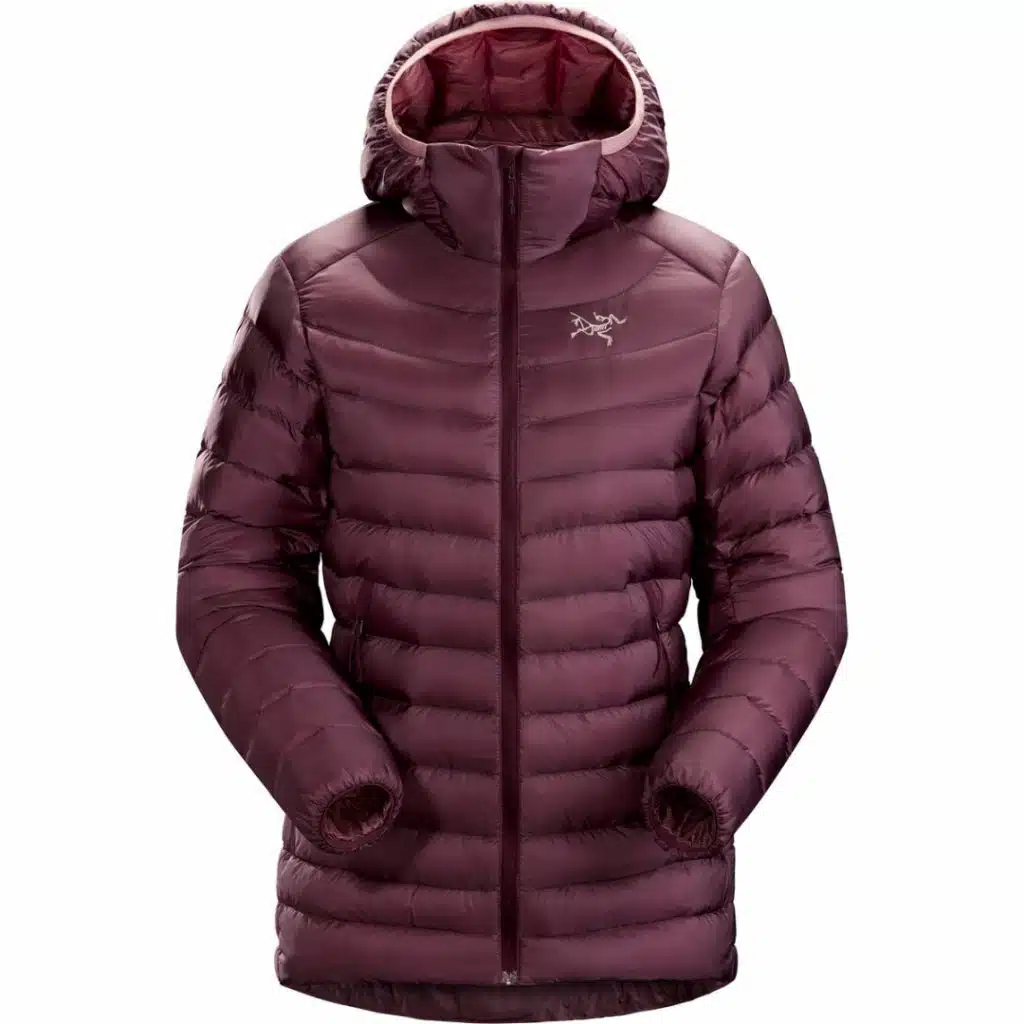
Down Jacket
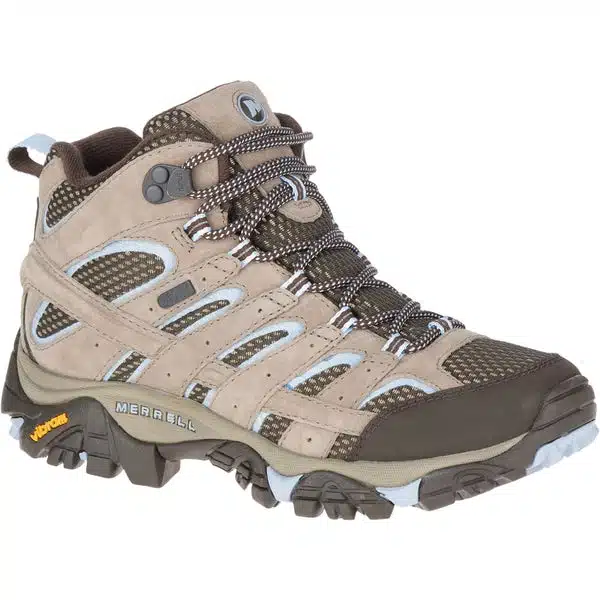
Hiking Boots
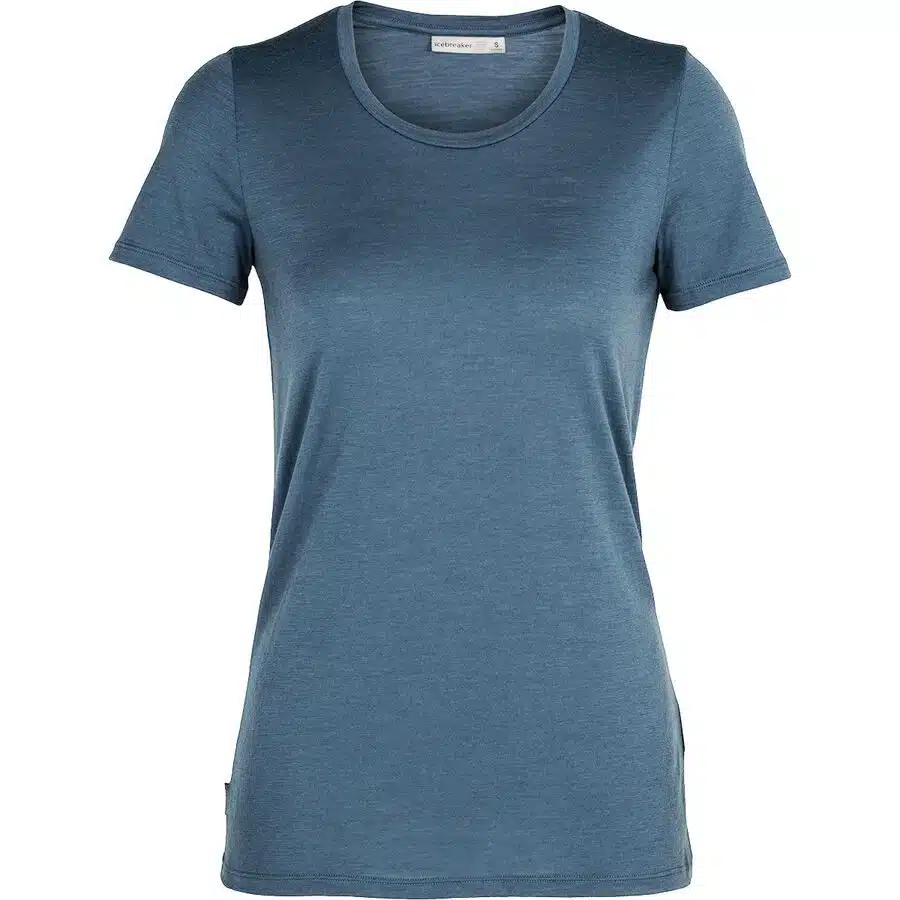
Hiking Shirt
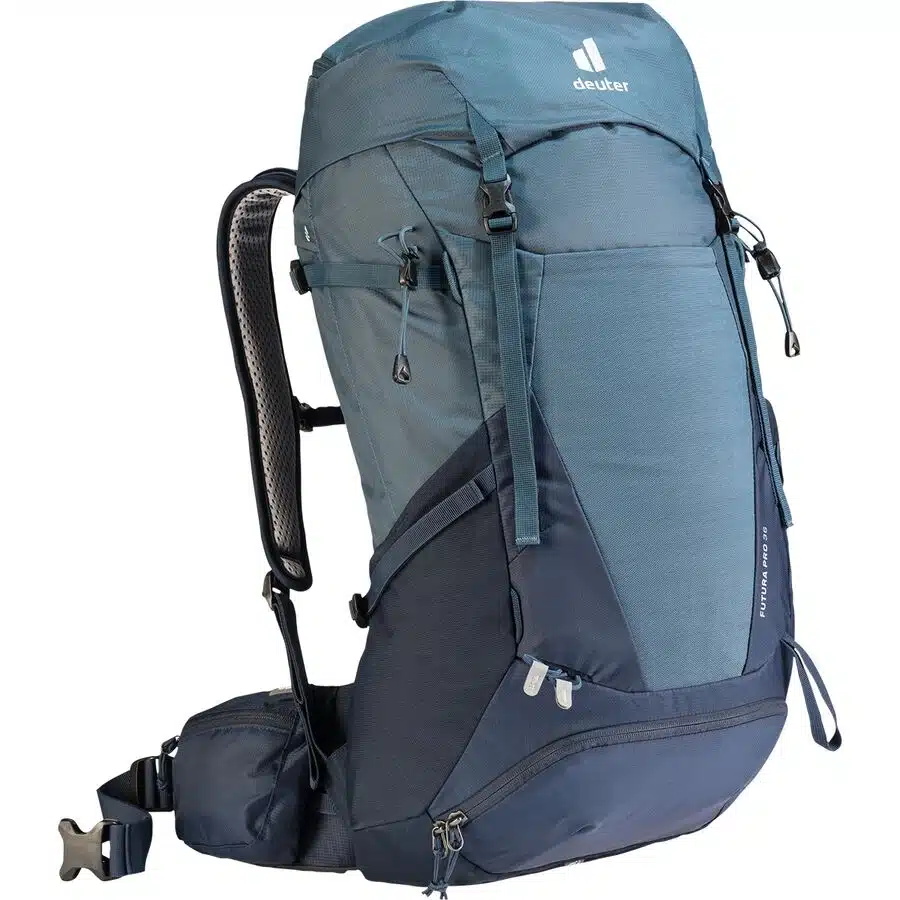
Hiking Pants
1 thoughts on “ Canoe Camping Meals: 10 Easy Canoe Trip Recipes ”
Stay in touch.
Join our community of outdoor adventurers - you'll find trip inspiration, gear discussions, route recommendations, new friends and more!
Where do you source your cheesecake powder. I am only able to see very large quantities for over $100. I can see a Jello no Bake cheesecake mix, but it doesn’t seem the same as the cheesecake powder.
Leave a Reply Cancel reply
Your email address will not be published. Required fields are marked *
Save my name, email, and website in this browser for the next time I comment.
- Facebook Group

How to Plan Food for a Canoe Camping Trip
By sarah coupal & aaron owens mayhew, ms, rdn, cd, updated january 4, 2024.
This post may contain affiliate links.
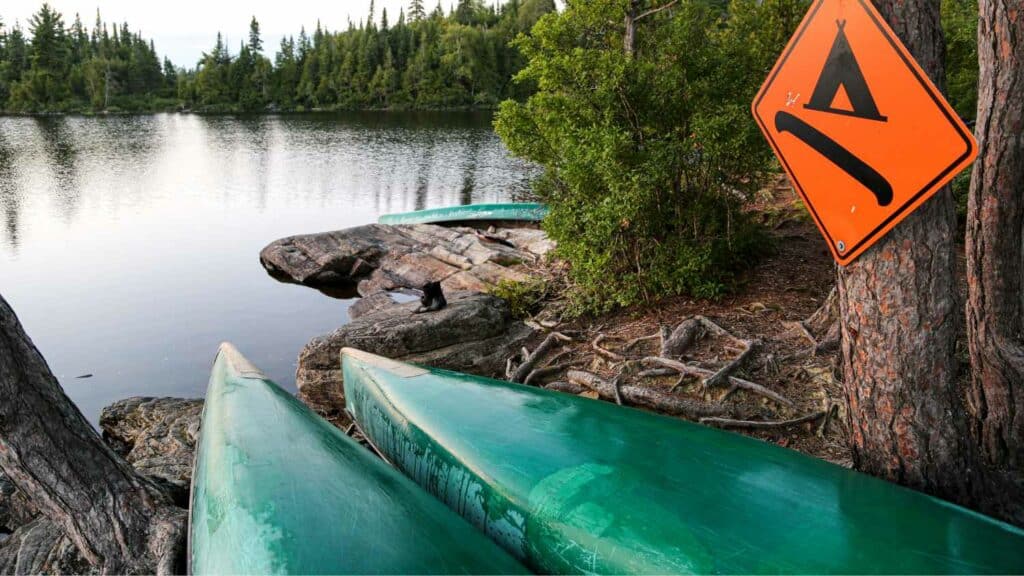
Factors to Consider | Amount of Food to Pack | Which Foods to Bring | Canoe Trip Hydration
Curious about packing food for canoe camping trips? Are you looking to transition from day paddles to overnight trips? Whether you are an experienced paddler looking to improve your nutrition or just curious about what canoe camping is all about, this article is for you!
Here at Backcountry Foodie, our main focus is food to fuel your hiking and backpacking trips. That said, the food for a paddling trip (canoe, kayak, or SUP) is not too different. The fact that you don’t have to carry everything on your back might even give you more flexibility in your meal planning. If you’re a foodie and have never been canoe camping, this post might convince you to try it!
What is Canoe Camping?
Canoe camping trips are multi-day trips where you paddle between campsites on lakes and rivers. All of the gear you need is carried in your boat. When lakes and rivers do not connect, you must portage (carry) your boat and all your gear on trails or roads.
What Should I Consider When Planning Food for a Canoe Camping Trip?
First, think about the length of your trip. This will determine how much food you need to pack and the types of food you can bring. For shorter trips, you may be able to bring some fresh food. For long trips, space, weight, and the shelf life and durability of your food will be more of a concern.
You should know the mileage of your route and your average paddling speed . From this, you can calculate the hours per day you will be paddling and portaging (if applicable). This is important because you burn significantly more calories when exercising than when sitting at camp or floating down the river.
Think about the weather as well. Being on open water means you will be more exposed to wind, which could make it harder to paddle. Shivering can burn up to 400 extra calories per hour if you get wet from rain or capsizing.
Finally, how will you store your food? Some people have canoe barrels or wanigans , which are food storage methods designed specifically for canoe tripping. You can also use a backpacking bear can or do a classic bear hang. As always, check the food storage regulations for the area you will be camping in.

How Much Food Should I Pack for a Canoe Camping Trip ?
Well, it depends.
Many factors affect how much food you must pack for a canoe trip. Like backpacking, the best way to dial in on the fuel your body needs is to keep a food journal with the following details:
- Conditions of the trip
- What you ate
- How you felt
- Any other details you think are relevant
You can then use this information to plan for future trips, ensuring that what you pack is personalized to your needs.
Here are some general guidelines to think about when deciding how much food to pack:
- You could burn anywhere from 200-700 calories per hour for every hour of paddling. This wide range depends on your weight, fitness level, speed, and water conditions.
- Long portages will have a larger impact on your calorie needs compared to easy paddling for the same amount of time.
- For low-intensity paddles, aim to eat 30-60 grams of carbs per hour. For more intense exercise, you should be eating 60-90 grams of carbs per hour. See our Best Backpacking Foods for Energy post for more information about carbohydrate serving sizes and snacks.
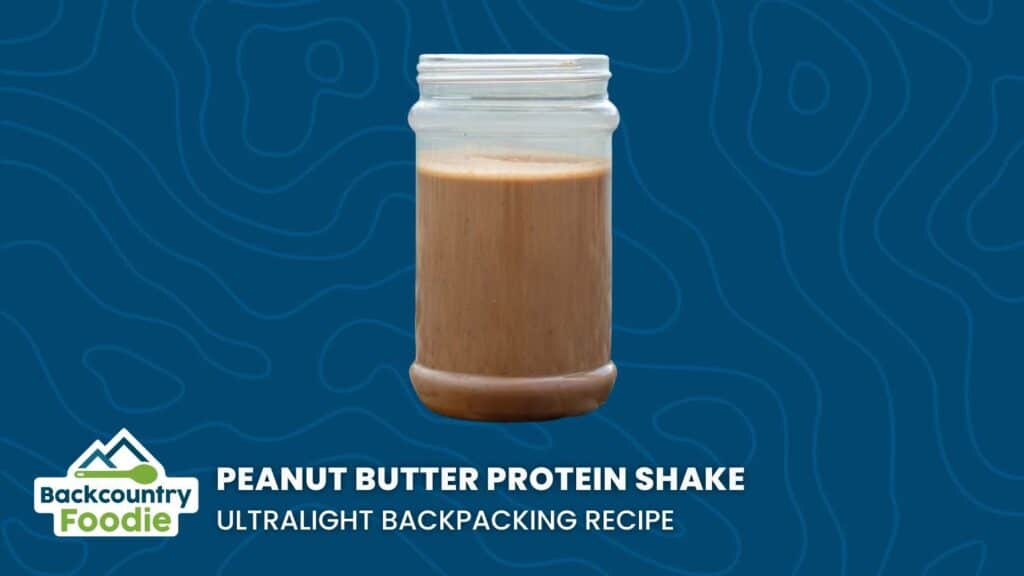
Are you also a day hiker or backpacker?
Here’s a great resource for determining calorie goals.
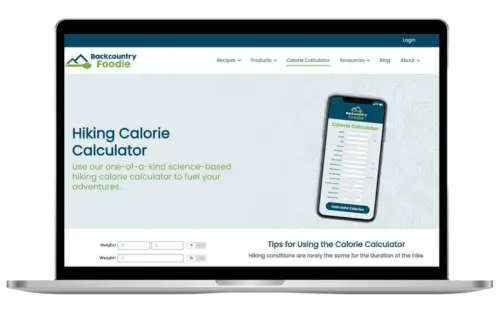
We created a one-of-a-kind hiking calorie calculator that takes all of the guesswork out of deciding how much food to pack for your adventures.
It’s a FREE resource, too!
Click on the link in the header bar or the button below.
What Food Should I Bring on a Canoe Camping Trip?
Choosing which foods to bring on your trip depends on personal preference and the details of your trip.
Short, Laid-back Trips
For short trips with few or no portages, many people opt to bring fresh foods similar to what they would eat at home. However, if you are planning to get into some serious backcountry cooking on your trip, we would not recommend bringing fresh meat, fish, eggs, or dairy products (with the exception of hard cheeses). These foods should not be kept unrefrigerated for more than 2 hours. Dry milk , powdered eggs , tuna or chicken packets, and jerky are good alternatives. Some foods also do not pack well (e.g., bananas), and the size of your food storage container (canoe barrel, bear bag) will determine how much you can pack.
Some fresh foods that keep well include:
- Potatoes, carrots, peppers, onions, cabbage
- Apples & oranges
- Sharp cheddar cheese
Leave No Trace
If you plan to bring fresh foods on your trip, make sure to pack out all food scraps to dispose of when you get home. It can take an orange peel up to 6 months to decompose! Also, make sure to wash your dishes away from water sources, even though it can be tempting to give them a rinse directly in the lake or river.
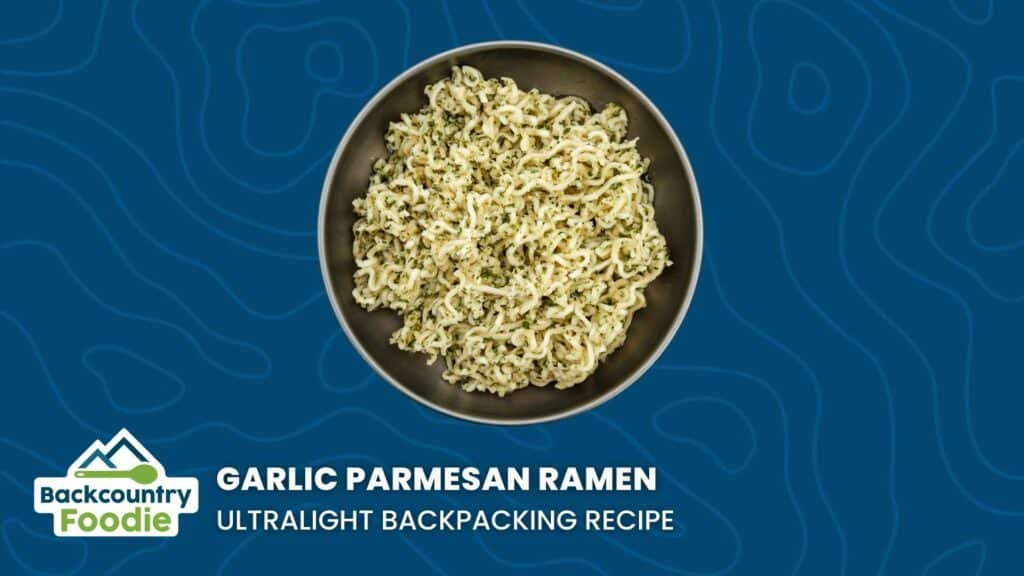
Longer, More Strenuous Trips
For multi-day trips and trips with long portages, we would recommend mostly dried foods. You’ll probably be trying to pack a lot of food in addition to all of your other gear. Backcountry Foodie has tons of great recipes that are low-volume, lightweight, and loaded with nutrition. These foods will last for even the longest trips.

Regardless of the length of your trip, make sure to pack plenty of snacks. Plan to eat every 30-90 minutes when you are actively exercising, depending on the intensity of your activity.
Don’t have time to prep DIY meals?
Not to worry! We offer a variety of Backcountry Foodie meals and meal replacement drink options in our shop . Here are just a few…
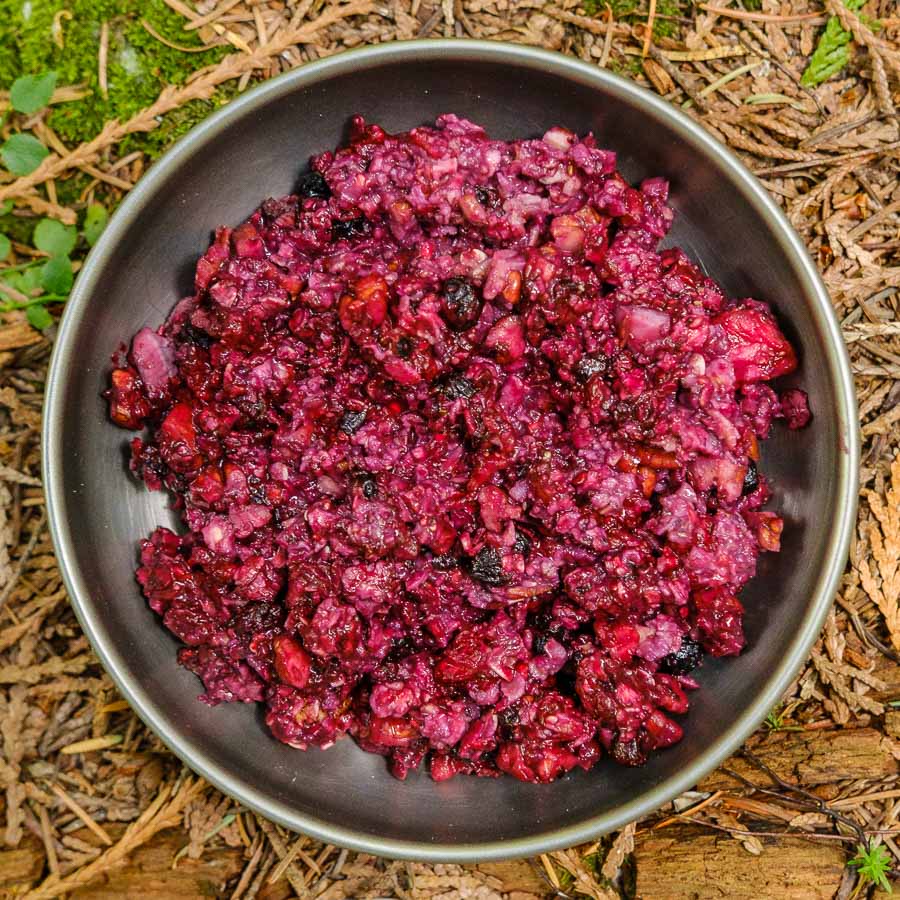
Sign-Up & Save!
Subscribe to our weekly newsletter & save 10% off Backcountry Foodie memberships.
Your email is safe with us. We don’t like spam either.
Hydration while Paddling
Hydration is an important part of fueling for paddling. You are often very exposed to wind and sun and might not notice how much you are sweating if your sweat evaporates quickly.
The amount of water you should drink per hour varies depending on how heavy of a sweater you are. For light sweaters, 0.5-1 liter of water per hour is a good estimate, whereas heavy sweaters can lose up to 2 liters of water per hour.
You also need to eat foods with salt to stay hydrated. You can lose 100-4000 mg of sodium (salt) per hour, depending on how much you are sweating and how salty your sweat is.
Some salty snacks to consider packing include:
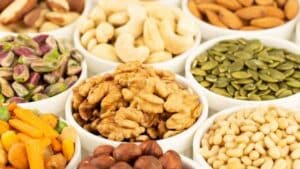
- Trail mix/salted nuts
- Dried hummus
- Triscuits or other crackers
As you might have noticed, canoe-tripping food is not too different from backpacking food. The best foods to pack vary depending on your trip and personal preferences.
Putting It Together
Keep in mind these factors the next time you are planning a canoe trip:.
- Length of your trip
- Miles you will travel each day
- Speed you plan to travel
- Food storage
- Personal needs and preferences
- Leave No Trace principles
Need Help Planning Food for Your Trip?
Backcountry Foodie is your go-to resource for more than 200 dietitian-created backpacking recipes and a one-of-a-kind automated meal planning tool. The meal planner even creates itemized shopping lists for you! Meal prep has never been easier.

Let us do all the heavy lifting for you !
Skip the hassle of resupplying during your hike . Let Aaron Be Your All-In-One Personal Chef, Shopper, Coordinator, And Dietitian!
DISCLOSURE: Some of the links on this page are affiliate links, which means we may receive a modest commission if purchases are made through those links. This adds no cost to our readers and helps us keep our site running. Our reputation is our most important asset, so we only include links for products we use ourselves.
Did you find this post helpful?
Pin it and share it with your fellow hikers..
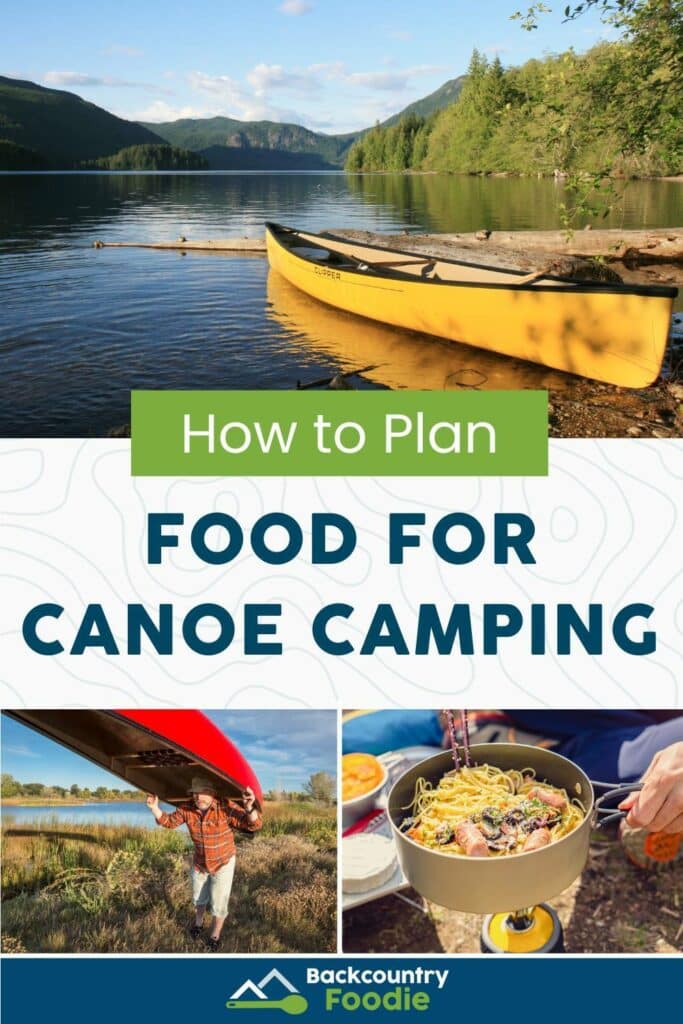
Are you new to our blog?
Consider checking out these posts:.
- Best Backpacking Foods for Energy
- What to Eat & Drink After Hiking: Our 3 Favorite Tips
- Backpacking Nutrition: Fueling Further Using the Goldilocks Approach
- Our Favorite 100 Grocery Store Foods
ABOUT THE AUTHORS:
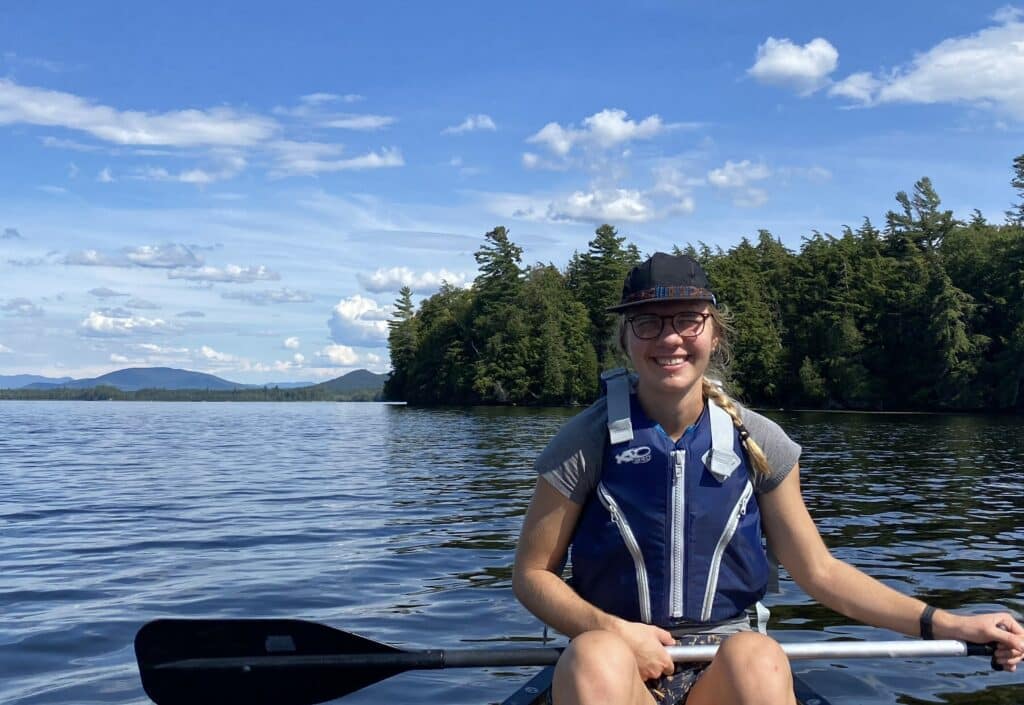
Sarah Coupal was a Dietetic Intern at Illinois State University mentored by Aaron when this post was originally written. She holds a BS in Nutritional Sciences from Cornell University and spent two summers as the Trails Food Coordinator for the Adirondack Mountain Club. She enjoys hiking/backpacking, canoeing, cross-country skiing, and running in her free time.
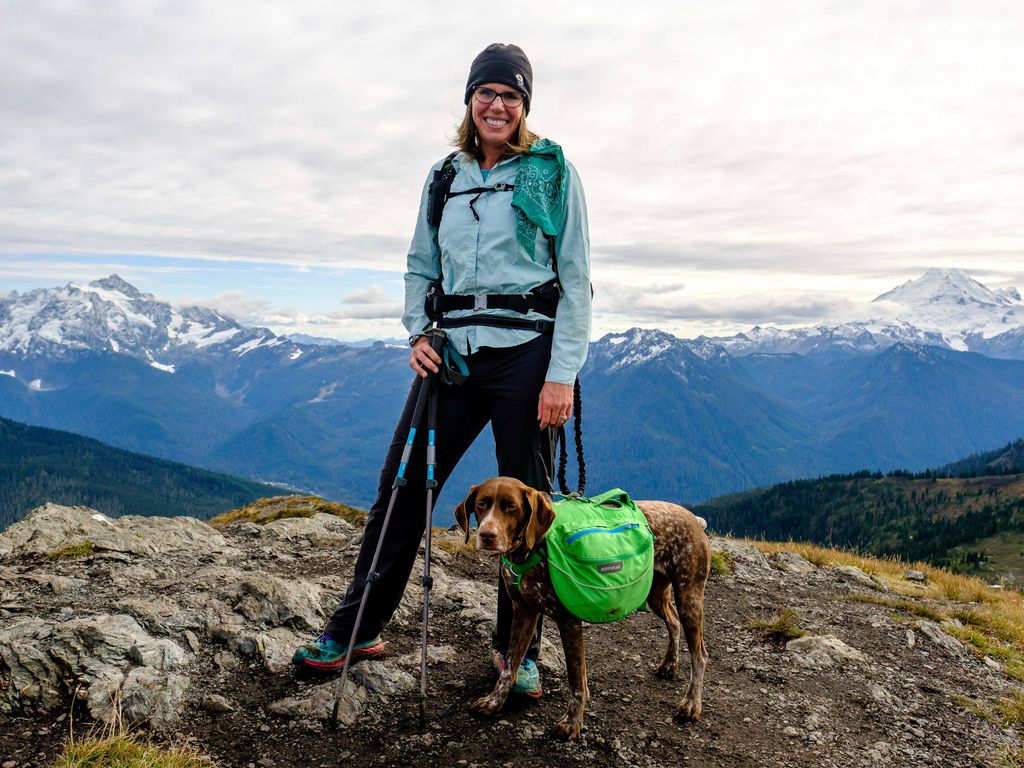
Aaron Owens Mayhew, MS, RDN, CD, is a registered dietitian and ultralight long-distance backpacker with over 20 years of nutrition and backpacking experience. She’s also the founder and owner of Backcountry Foodie , an online ultralight recipes and meal planning platform for backpackers. She also enjoys teaching hikers about backpacking nutrition via virtual masterclasses , YouTube videos , and podcast episodes . You can follow Aaron’s adventures in the kitchen and the backcountry via Instagram and Facebook .
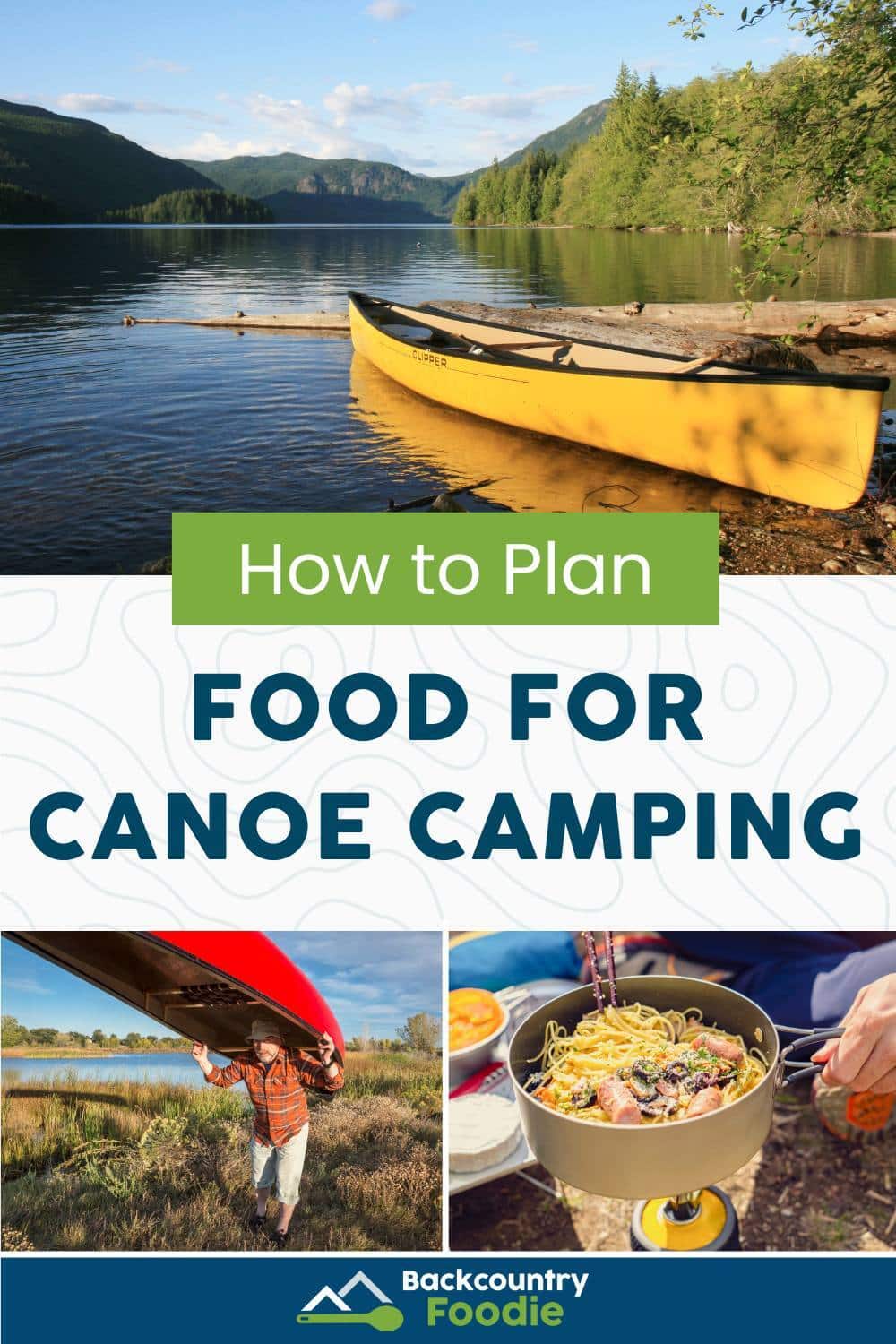
Leave a Reply Cancel reply
Your email address will not be published. Required fields are marked *
Save my name, email, and website in this browser for the next time I comment.
COMING SOON
Labor day sale.
Enjoy 20% off our memberships when you use coupon code LABORDAY20 at checkout!
Sale starts Friday, September 1st.
- 139 Pinterest
- 0 Copy Link

Canoe Trip Meals 101: Discover the Best Canoe Camping Meals
Canoe camping, also known as backcountry camping, is an adventure where you travel by canoe to a remote destination to find your campsite.
Unlike car camping, canoe camping involves being out in the wild with limited resources . There is no running water or electricity, meaning you must bring everything you need to make your canoe trip meals, including all cooking gear.
It is critical to plan your canoe camping meals to ensure you pack enough food to last your whole trip without carrying too much weight.

For all my camping trips over the years , I came up with canoe trip food ideas according to the trip duration, dietary requirements within the group, and the resources available.
For example, while on a yurt camping trip in Tobermory , we could use a BBQ and cooler. However, on backcountry camping trips in Algonquin Park , we had no equipment except for the fire we made and a camping stove. Therefore, I have come up with plenty of ideas for food to bring camping with no cooler.
Therefore, this article will take a look into the necessary preparation required for canoe trip meals.
If you are planning a canoe trip, make sure you check out my backcountry camping guides – you can find all my other camping articles here.
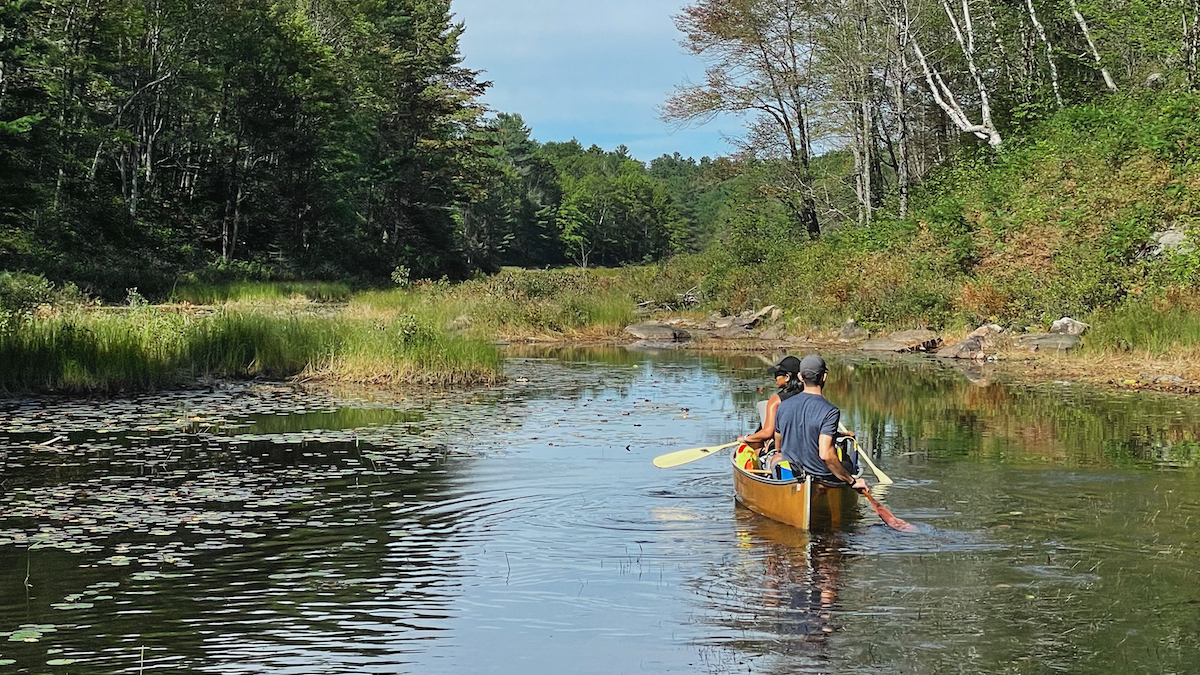
FREE Canoe Camping Packing List
Sign up to receive your free checklist to prepare you for your next backcountry camping trip.
Thanks for signing up!
You will receive an email with your freebie in the next 10 minutes.
Important Considerations for Planning Your Canoe Trip Menu

You need to keep your body nourished during a canoe trip so you have enough energy to paddle and hike throughout your camping adventure.
It is important to bring foods that are high in energy , but also non-perishable . You also want to stay fuelled on your canoe trip, but still be able to carry the weight.
There are several important considerations to help you choose your backpacking foods. These include the trip duration, the equipment available, the amount of food you want to consume, and any dietary restrictions.
Trip Duration
Trip duration is important to consider when preparing your canoe camping menu because it determines the amount and type of food you need to bring. The longer the trip, the more food you will need to pack.
However, if your backcountry camping trip exceeds three days, you should bring dehydrated meals and non-perishable snacks. This type of camping food is the lightest and will not spoil.
If you are going backcountry camping, bring a camping stove that is fully operable in the wilderness.
At some campsites, you can use the fire pit to cook some food. However, it is not always possible to use a fire pit due to fire restrictions or wet weather conditions. Therefore, you need to be prepared for all occasions.
Read about what else to pack for a backcountry camping trip in this article.
Amount of Food

The amount of food you need to bring depends on how many people are in your group, the number of meals and snacks you plan to eat each day, how much you can carry, plus the duration of your trip (as previously discussed).
On all my camping trips, we eat three full meals a day , plus snacks , and sometimes a dessert . Our food barrel is heavy at the start of the camping trip, and it reduces in weight over the days as eat the food.
However, our trips rarely last longer than three days; therefore, we can get away with using fresh food at the start.
For the latter part of the trip, we rely on foods that do not require chilling, such as cured meats and dried vegetables.
While it may be tempting to bring a light menu for your camping trip, you should consider the amount of physical activity you will be doing. You will likely be expending a lot of energy while paddling and need extra food to keep your energy levels up.
Dietary Restrictions
Before planning your canoe trip meals, check with all group members if they have any dietary restrictions. It is usually easier for all members to eat the same diet , rather than packing separate meals.
For example, if you have a group member who needs a gluten-free diet, bring gluten-free pasta for the whole group, or opt for a naturally gluten-free alternative, such as rice or quinoa.
Otherwise, you can bring dehydrated foods that each member has chosen to suit their requirements.
Picking the Right Food for Canoe Trips

As explained previously, the best foods for camping are non-perishable, lightweight, and high-energy foods.
When camping menu planning, remember that space and weight are limited .
Packing compact and nutrient-dense foods is critical, so consider foods that are easy to prepare, such as dehydrated or freeze-dried meals, and snacks like trail mix and energy bars.
Carbohydrates are particularly important because they provide the body with energy for physical activity. Good sources of carbohydrates include pasta and rice.
Finally, consider the perishability of the food you bring.
Foods prone to spoilage, such as fresh fruits and vegetables, may not be suitable for long canoe trips. Instead, consider dried fruits and vegetables. Additionally, bread is a good carbohydrate, but it is bulkier and will expire quicker than rice or pasta.
Non-Perishable Camping Meals

Non-perishable food items are those that can be stored at room temperature for an extended period without spoiling. This is important because you will not have access to refrigeration on a backcountry camping trip.
Suggestions for Non-Perishable Canoe Food
Here are some of the best canoe trip meals and snacks that are quick to prepare and and lightweight to carry.
- Peanut butter and jam/jelly wraps
- Instant oatmeal packets – good canoe trip breakfast option
- Packaged pasta kits (e.g. just add water mac & cheese)
- Instant noodles
- Granola bars
- Energy bars
Dehydrated Meals for Camping Trip
Dehydrated meals are a great option for canoe camping due to their convenience, ease of preparation, and portability. They are cooked using boiling water , which is suitable for those who want a hot meal without too much preparation time.
Dehydrated meals also have a long shelf life and are non-perishable, making them ideal for longer canoe trips where fresh food is not a viable option.
You can also purchase freeze-dried meals.
Recommended Brands for Dehydrated Meals

I have tested and recommend the following brands of dehydrated meals:
• Firepot • Peak Refuel • Mountain House • Backpacker’s Pantry • Good To Go • Alpine Aire
Dehydrated Meal Recommendations
If you are looking for specific canoe camping food ideas, here are some of my favourite dehydrated meals.
Dairy-Free Camping Meals

If you are lactose-intolerant , it is a good idea to take this seriously while backcountry camping, given the lack of facilities.
It is possible to bring lactose-enzyme products (such as Lactaid) , but it is easier to plan a canoe trip menu that lacks dairy.
A dairy-free camping menu is also beneficial to avoid any bloating or discomfort.
You can swap out cheese with nutritional yeast to give a similar flavour in foods like homemade pesto that would normally include parmesan (as shown in the adjacent image).
Suggested Dairy Free Camping Meals and Snack Ideas
Here are some canoe trip meal ideas that are dairy-free or lactose-free.
- Oatmeal, dried fruit, and nuts (great breakfast option)
- Hummus and veggie wraps
- Pasta with tomato sauce
- Beef stir-fry or fajitas (for the first day of camping)
Suggested Canoe Camping Recipe
Below is one of my favourite canoe trip recipes that makes a great dinner choice.
Given the non-perishable ingredients used, it is a good option for the latter part of your canoe trip if you plan to cook all your meals from scratch. Alternatively, it is a good choice for your first day of camping if you eat dehydrated meals later in the camping trip to travel light.
Sun-Dried Tomato and Chorizo Orzo
For two people
- 3/4 cup orzo (uncooked) – use quinoa for a gluten-free substitution
- 100g of cured chorizo – (or between ½ to 1/3 of the package and use the rest for wraps/sandwiches/eggs)
- 6 pieces of sun-dried tomatoes – (not in oil)
- 1 stock cube – one is good for 2 to 4 people (chicken is my favourite)
- Splash of olive oil (bring a small portion in a portable container)

You can scale the recipe up for additional people.
- Gently heat a splash of oil in a pot or saucepan.
- Add diced chorizo to the pan and allow it to sweat.
- Add the dried orzo and stir until the orzo is coated in the oil from the chorizo.
- Add in chopped sun-dried tomato.
- Add purified drinking water along with the stock cube (use double the water to orzo). Stir until the stock cube dissolves.
- Let it cook for around 10 minutes. Turn off the burner once the water is soaked up and the orzo is soft.
Equipment Required for Recipe
- Saucepan ( stove and cookware bundle available here )
- Folding stirring spoon/spatula ( camping utensil set available here )
- Chopping board
- Insulated mug/jug
- Camping stove
- Camping plates/bowls
- Small oil container
Preparing Your Canoe Camping Meals

Read on to learn more about how to pack food for camping to be efficient and organised.
Your canoe camping menu should be based on the equipment you will be bringing with you.
Do not pack food that requires chilling unless you have a cooler, which is not recommended when backcountry camping .
Alternatively, you can freeze some of your protein , such as chicken or beef, so it stays chilled and will slowly defrost during day one of the trip. With this, you can eat some fresh food on your first night of camping.
Typical equipment for a backpacking camping trip includes a portable stove, fuel, saucepan, frying pan, utensils (forks, knives, spoons), and a sharper knife for cutting.
You should also pack the following items: biodegradable dish soap , a sponge, and trash bags. These items will assist with proper cleaning and waste disposal.
Check out this stove and cookware bundle (including Sauce Pan, Deep Dish Bowls, two Insulated Mugs, Strainer Lid, and two Folding Sporks) and this camping utensil set (including Folding Spoon, Spatula, Ultralight Cutting Board, Salt & Pepper Shaker, Squeeze Bottle and Dish Towel).
Read this article on packing for a backcountry camping trip to guarantee you pack all the essentials.
No Cooler Camping Meals
One of the biggest challenges of planning meals without a cooler is that you should select foods that will not spoil without refrigeration. Many fresh foods, such as meats, dairy products, and some vegetables, are not recommended for camping.

Without the ability to store meats and dairy products, you may need to rely on canned or dried proteins like beans or cured meats.
Pack some meal and snack options that do not require refrigeration, such as:
- Instant ramen noodles
- Canned soups and stews
- Pasta with chorizo and sun-dried tomatoes (see the above recipe)
- Peanut butter sandwiches
- Dried fruit and nut mix
- Dehydrated meals
- Crackers or rice cakes
What are Good Snacks for Camping?
- Trail Mix (including nuts and seeds)
- Granola Bars
- Fresh Fruit, such as apples
- Dried Fruit, such as apricots
- Energy chews or bars (Honey Stinger Organic Energy Chews or Clif Bloks Energy Chews)
Staying Hydrated While Canoe Camping

It is important to replace the fluids lost while sweating from physically demanding camping activities.
Adding electrolyte tablets to your water bottle will help you replenish electrolytes and other fluid requirements to ensure hydration.
Nuun Electrolyte Tablets are my favourite brand and are available in Canada and the United States. I like grape and lemon-lime flavours.
Make sure you use treated, potable water . See the methods below for how to accomplish this while camping.
Water Treatment Methods for Canoe Camping

During most backcountry camping trips, you need to find water to drink, meaning you will collect water from natural water sources, such as lakes or rivers.
You cannot drink the water directly from a lake because you can get beaver fever ; therefore, you must treat the water first.
The two most common ways of treating water are by water gravity bag or water purification tablets.
Water Gravity Bag
A water gravity bag works by using gravity to filter water through a filter cartridge, removing bacteria and other contaminants.
This method is easy to use; however, it is the more expensive option.

Water Purification Tablets
Water filtration tablets use a chlorine solution to kill bacteria in the water. This method is cheaper and easy to carry but can make the water taste “off”.
Storing and Transporting Food
There are numerous methods for storing food that to keep yourself safe while camping. The following tips will help you avoid attracting wildlife while camping and efficiently pack your food.
1. Use Bear-Safe Storage Containers

Firstly, store your food products in bear-resistant containers.
You can use a food barrel , a bear bag , or a bear canister .
Certain containers can be hung from a tree, which makes it more difficult for a bear to get hold of its contents.
Otherwise, store your canister at least 30 metres (100 feet) from your campsite . The containers are designed to be difficult for bears to open.
Canoe Camping Food Storage Options
• Food Barrel • Bear Bag • Bear Canister
2. Pack Fewer, Larger Bags
Pack your items in as few storage containers as possible to help with transporting your food.
If you need to portage (carry your canoe and camping belongings to the next stretch of water), it will be easier with fewer, big items to carry. Plus, it can help when distributing the weight of items within the canoe.
3. Keep Odours Contained
Within the containers, it is good practice to keep individual food items and toiletries that are scented in sealed bags to minimise smells.
For example, once you have opened a package of cured meats, reseal it in a Ziplock bag.
4. Keep Your Campsite Clean

Ensure your campsite remains clean by securing waste in a plastic bag and placing that in your bear-proof container. You also need to wash your cooking and eating utensils straight after mealtimes.
Do your dishes away from your main camping area and dispose of the water in a hole away from water sources. You do not want to contaminate lakes or rivers with your dirty dishwater.
You can do this using a collapsible sink .
Conclusion – Canoe Trip Food
In conclusion, meal planning for canoe camping can be challenging, but you will be glad you put in the preparation.
Dehydrated meals, along with other non-perishable and no-cook options, are convenient choices for backcountry trips. The main benefits of dehydrated meals are that they help to keep your bags light and feed you nutritious, warm meals no matter how long your camping trip is.
It is important to pack out all your trash and food waste to keep the campsite clean and preserve the wilderness. Adhering to the Leave No Trace principles is essential for responsible camping, which ensures minimal environmental.
So, be mindful of what you pack, respect the environment , and enjoy the canoe camping with delicious meals.
Samantha is the founder of Continuous Roamer, a travel website focusing on adventure and the outdoors.
With a love for adventure and the great outdoors, Samantha shares tips on skiing, luxury safaris, camping, and finding hidden food gems in different destinations.
With over 20 years of skiing experience across Europe, North America, and beyond, she's also an expert in luxury accommodations and experiences.
Whether camping in Canada or dining in a Michelin-starred restaurant, Samantha always seeks out the best experiences and accommodations, and her blog highlights the best of them for her readers.
Samantha is currently living in London.
Similar Posts

Yurt Camping Tobermory: Everything You Need to Know For a Memorable Trip
Before I went yurt camping in Tobermory I tried to do some research online. Other than what Parks Canada, the…

Complete Guide to Algonquin Portages & Backcountry Camping
As someone who has spent the past four summers embarking on numerous backcountry camping trips in Algonquin Park, I have…

Rock Lake Algonquin: First-Time Backcountry Camping Guide
Rock Lake Algonquin Park in Ontario, Canada is a beautiful destination for backcountry camping in Ontario. It was the first…

Magnetawan Lake Access: How to Plan Your Backcountry Adventure
Ontario Canada has some of the best camping locations in North America because Ontario is home to the magnificent Algonquin…

Canoe Trip Pack List: 62 Essentials for Backcountry Camping
Are you planning a backcountry camping trip in North America this summer? I have been on several canoe trips in…

Canoe Camping Meals: Guide to Easy and Nutritious Options for Paddlers
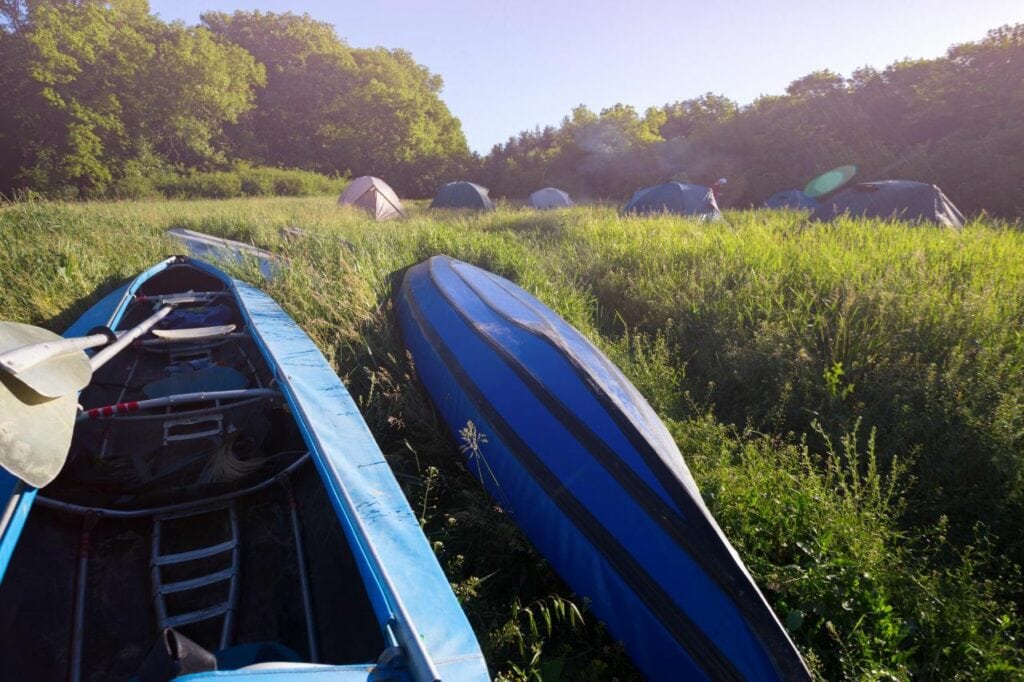
We're an affiliate. We hope you love the products we recommend! Just so you know, we may collect a share of sales or other compensation from the links on this page. Thank you if you use our links, we really appreciate it!
Going on a canoe camping adventure is a fantastic way to immerse yourself in nature while enjoying the tranquility of paddling through serene waters. One of the highlights during such excursions is the chance to delight in delicious and satisfying meals around a campfire by the shore. Backcountry cooking is an essential skill for canoe campers, and with a little meal planning, you can make sure to impress your fellow paddlers.
Canoe trip meals should be easy to prepare, delicious, and provide enough energy for your paddling adventures. Whether it’s breakfast, lunch, or dinner, having a variety of canoe camping recipes in your arsenal ensures that you and your companions can enjoy good food throughout your journey. From rehydrated meals to delightful one-pot dishes, there are numerous options to suit your taste and nutritional requirements.
When you embark on a canoe camping trip, remember that the paddle itself can be physically demanding. As such, it is crucial to choose meals that will keep you feeling invigorated and satisfied. With a bit of preparation and creativity, you can indulge in fantastic backcountry cooking experiences and turn your canoe camping adventure into an unforgettable culinary journey.
Preparing for a Canoe Camping Trip

Meal Planning for Canoe Camping
When planning meals for your canoe camping adventure, take into consideration your caloric needs, physical activity, weather, and duration of the trip. Aim to create a meal plan that provides a good balance of carbohydrates, proteins, and fats, with an emphasis on lightweight, non-perishable ingredients. Staples such as rice, pasta, and oatmeal can be combined with dehydrated vegetables, beans, and various proteins like jerky or canned fish.
Remember to pack some snacks for in-between meals, such as energy bars, trail mix, or dried fruits. Don’t forget to account for cooking oil, spices, and condiments to enhance the flavor of your dishes. Consider your dietary restrictions or preferences while creating your meal plan.
Packing Food for the Trip
Proper food storage and packing will ensure your meals stay fresh and lightweight throughout the trip. Use resealable plastic bags or airtight containers to pack your meals in portions while reducing bulk and potential food waste. Dry backpacking foods can be rehydrated with water directly in their containers, making them both space-saving and convenient.
For short canoe camping trips, you may prefer to bring some fresh foods, such as fruits, vegetables, or sandwiches. However, keep in mind that perishable items may spoil quickly, especially during warmer weather, so pack accordingly.
Cooking Gear Essentials
Assemble a lightweight and functional cooking gear set for your canoe camping trip. A compact camping stove, such as a canister or liquid fuel stove, is a great addition to your gear, especially in areas where open fire pits may not be allowed or where natural fire sources are scarce.
A portable fire pit can be an alternative cooking option if open fires are allowed at your campsite. Include a set of lightweight, durable pots, pans, or a Dutch oven for versatile cooking. Bring a spork, bowl, and a mug for each camper to use during meals.
Adhere to Leave No Trace principles by cleaning up all food waste and washing your dishes responsibly. Practicing proper backcountry camping ethics will help preserve these natural areas for future paddlers to enjoy.
Breakfast Ideas for Canoe Camping
Oatmeal and granola dishes.
Starting your day with a warm and hearty breakfast is important, especially during a canoe camping trip. Oatmeal is easy to prepare, customizable, and packed with energy. You can mix in various ingredients such as dried fruit, chopped nuts, brown sugar, and chia seeds to create your own unique flavor. Additionally, granola bars are perfect for a quick, no-cook option. Choose bars that contain a good amount of protein and healthy fats to keep you full and energized.
Egg-Based Meals
Eggs are a fantastic source of protein and can be used in numerous meals while camping. Breakfast sandwiches using powdered eggs, bacon bits, and sausage are a simple, filling option. Early in the trip, you can use English muffins, but for later meals, consider using wraps as a more portable alternative. If you want to level up your egg game, try creating a one-skillet dish by adding various ingredients such as vegetables, cheese, and cooked bacon or ham.
Portable Breakfasts
On busy mornings or when you’re in a hurry to break camp, portable breakfast options are a lifesaver. A favorite among campers are cinnamon buns—prepared in advance and individually wrapped, they make for a delicious handheld meal. Another option to consider is a savory calzone made with just-add-water pizza dough, pepperoni, and shelf-stable cheese, cooked over a campfire.
Warming up with a hot beverage is essential during those chilly canoe camping mornings. Don’t forget to pack coffee, tea, or hot chocolate to suit your personal preferences. If you enjoy milk in your drinks, powdered milk is a lightweight and non-perishable alternative. Pairing your hot drink with your breakfast meal will give you the energy you need to paddle your way through a busy day on the water.
Lunch Ideas for Canoe Camping
Sandwiches and wraps.
When canoe camping, you’ll want portable, easy-to-prepare lunches that don’t skimp on taste. Sandwiches and wraps are perfect for this. Stick with durable breads like bagels or tortilla wraps for maximum practicality. Fill your sandwiches with ingredients like cheese, hummus, or peanut butter, which last longer without refrigeration. Don’t forget to add a variety of veggies, like lettuce and tomato, for extra crunch and flavor. Always pack fixings separately to prevent soggy sandwiches that nobody wants to eat.
Quick and Easy Lunches
For busy canoe campers who don’t want to spend much time on food preparation, consider packing snacks that can be combined into a satisfying lunch:
- Crackers : Triscuits or other sturdy crackers pair well with cheese, hummus, or nut butter for a quick bite.
- Nuts and Trail Mix : A variety of nuts, along with a good trail mix, can provide valuable energy and satiate hunger when on the go.
- Beef Jerky : A high-protein snack that requires no preparation.
One Pot Meals
Sometimes, you’ll crave a hot meal in the middle of the day. One pot meals are perfect for simplifying your canoe camping lunch experience. Consider using a portable stove to whip up these delicious, easy dishes:
- Chili : Make a simple, delicious chili by cooking beans, canned tomatoes, and spices in one pot. You can even add dehydrated vegetables or meats to your chili for extra flavor and protein.
- Soup : Pack some instant soup mixes for a quick, light lunch option. Simply add water and cook in one pot. Try varieties like vegetable, lentil, or chicken noodle.
- Grain-based dishes : Quinoa or rice-based recipes make hearty, satisfying meals. Cook the grains in water and toss in a few dehydrated veggies, seasonings, or precooked meats. Stir everything together in one pot for a tasty, filling lunch.
Dinner Ideas for Canoe Camping

Hearty Dinners
When you’re on a canoe camping trip, nothing beats a hearty dinner after a long day of paddling. Here are a few options that are easy to prepare:
Pasta and Beans :
- Ingredients : pasta, canned beans, tomato sauce, olive oil, seasonings (salt, pepper, Italian herbs)
- Directions : Boil pasta according to package instructions. Heat up beans and mix with tomato sauce. Add olive oil and seasonings. Combine with pasta and serve.
Wild Rice and Lake Trout :
- Ingredients : wild rice, fresh lake trout (or other fish), olive oil, salt, and pepper
- Directions : Boil wild rice according to package instructions. Season the trout with salt and pepper, then wrap it in tin foil and place on hot coals. Cook until the fish is cooked through, and serve with wild rice.
Gourmet Canoe Trip Meals
Impress your fellow campers by elevating your cooking game with the following gourmet canoe trip meals:
Swedish Hardtack with Sausage and Cheese :
- Ingredients : Swedish hardtack, summer sausage, hard cheese, mustard
- Directions : Cut sausage and cheese into thin slices. Assemble on a piece of hardtack and top with mustard. Enjoy the gourmet taste in the great outdoors.
Vegetable Stir-Fry :
- Ingredients : rice, a variety of vegetables (e.g., carrots, zucchini, bell peppers, mushrooms), olive oil, soy sauce, ginger, garlic
- Directions : Cook rice according to package instructions. Chop vegetables into small pieces. Heat oil in a pan over the campfire, add vegetables, and cook until tender. Add soy sauce, ginger, and garlic. Stir-fry for a couple more minutes, and serve over rice.
Campfire Cooking
Cooking over an open fire adds an enjoyable and tasty element to your canoe camping experience. Here are a couple of simple options:
Bacon-Wrapped Sausages :
- Ingredients : sausages, bacon
- Directions : Wrap each sausage with a slice of bacon. Slide a stick through both ends of the wrapped sausage. Hold or prop the stick over the fire pit until the bacon is crispy and the sausage is cooked through.
Fire-Grilled Vegetables :
- Ingredients : your favorite vegetables (e.g., bell peppers, zucchini, mushrooms, onions), olive oil, salt, and pepper
- Directions : Chop your choice of vegetables into large pieces. Toss in olive oil, and season with salt and pepper. Create little foil pouches and seal the vegetables securely. Place flat on hot coals to cook, flipping occasionally, until tender.
Snack Ideas for Canoe Camping
While out on a canoe camping trip, it’s essential to have a variety of snacks to keep your energy levels up. Here are some delicious and easy-to-pack options for your next adventure.
Nuts and Trail Mix: Nuts are a fantastic source of protein and healthy fats. Bring a variety of your favorite nuts such as almonds, cashews, and walnuts. You can also make your own trail mix by combining nuts with dried fruits like raisins, cranberries, or apricots. For extra indulgence, throw in some chocolate chips or M&Ms.
Beef Jerky: For a protein-packed snack, beef jerky is an excellent choice. It’s lightweight, delicious, and comes in many different flavors. You can even find vegan and vegetarian options made from plant-based proteins.
Granola Bars: Granola bars are a tried-and-true canoe camping snack. Look for those made with whole grains, nuts, and dried fruit for maximum nutrition. If you’re feeling creative, you can even make your own before the trip by mixing together oats, nuts, dried fruit, and a sweetener like honey or maple syrup.
Fruit: Fresh fruit may not be practical for long trips, but it’s an excellent addition to your snack rotation for shorter outings. Apples, oranges, and bananas are great choices that can withstand rough handling. For longer journeys, opt for dried fruit like raisins, cranberries, and mango.
Chocolate: Don’t underestimate the mood-lifting power of chocolate! Pack a bar or two for those moments when you need a little pick-me-up. Keep in mind that chocolate can melt on hot days, so consider packing chocolate-covered nuts or treats that are more temperature-resistant.
Incorporate these snacks into your canoe camping meal plan to ensure you have plenty of tasty options throughout your trip. Remember, maintaining your energy levels is crucial to enjoying your adventure and staying safe on the water.

We’re passionate about getting the most from your car when it comes to going on adventures and road trips. When you take one of these trips you often need more room in your car than you usually would. This is when we come in, to help you find the best roof tent for your car and needs.
Leave a Comment Cancel Reply
Your email address will not be published. Required fields are marked *
- Recreational Day Trips
- Longer Touring Excursions
- Straight Shaft
- Solo Canoeing
- Recreational Fishing
- Longer Fishing Excursions
- High-Visibility
- Hook Retrieval
- Versa-Lok Ferrule (Adjustable)
- Snap-Button (Fixed Length)
- All Sale Paddles
- New Arrivals
- All Apparel
- Accessories
- Cosmetic Seconds
- All Sale Items
- Bending Branches Team
- National ProStaff Team
- Regional Ambassador Team
- Wood Paddle Care
- Composite Paddle Care
- Factory Tours
- Canoe Sizing Guide
- Solo Canoe Sizing Guide
- Pack Canoe Sizing Guide
- Kayak Fishing Sizing Guide
- Kayak Sizing Guide
- Rockgard® Edge Protection
- Bent vs. Straight Paddle
- Paddles for the Solo Canoeist
- Versa-Lok Ferrule System
- Snap-Button vs Plus Ferrule
- Plus Ferrule System
- New At Bending Branches
- Black Pearl ST
- Dealer Locator
- Paddle Finder
- instagram Instagram
- twitter Twitter

- Learn Blog FAQ's Cosmetic Seconds Wood Paddle Care Composite Paddle Care Factory Tours Paddle Sizing Canoe Sizing Guide Solo Canoe Sizing Guide Pack Canoe Sizing Guide Kayak Fishing Sizing Guide Kayak Sizing Guide Choosing a Canoe Paddle Rockgard® Edge Protection Grip Guide Bent vs. Straight Paddle Paddles for the Solo Canoeist Choosing a Kayak Fishing Paddle Versa-Lok Ferrule System Snap-Button vs Plus Ferrule Plus Ferrule System Product Highlights New At Bending Branches Black Pearl ST
Canoe Trip Food: What Are Your Options?

8-minute read
By Sharon Brodin
A multi-day canoe trip is a unique wilderness experience that, like backpacking, means you pack your food wherever you go. Let’s look at your options for canoe trip food so you can make the best choices for your group and situation.
When it comes to canoe camping meals there’s no right or wrong. Some people want light and easy meals. Others want gourmet. Some love camp cooking, others just want to have a full belly. What you decide will depend on quite a few factors including whether you're planning long trips or shorter trips.
There are three basic options when it comes to meals for your wilderness canoe trip: “real” food (non-dehydrated), pre-packaged dehydrated meals marketed to backpackers, and DIY dehydrated meals.
There are pros and cons to each of these:
Bring “Real” Food
PROS: Tastes great • healthy • budget-friendly
CONS: Heavy • Takes up more room in the pack • somewhat labor intensive to plan and prepare both before and during the trip
BEST FOR: Trips with little to no portaging • short trips • strong portagers • fresh food lovers
Back in the 80s when I was a camp counselor in northern Minnesota, we brought teens on 5-10 day canoe trips in the Boundary Waters. In those days—at least at low-budget small ministries like ours—expensive pre-packaged backpacking food wasn’t an option (I’m not sure it was even on the market at the time).
We brought “real” food along on these trips. We had a food pack it all fit in, including the cook kit. It was our heaviest pack at the start of each trip and of course would lighten up after every meal.
When our family (my husband and I, plus our three teens) joined another family (with a husband, wife and their teen) for a 5-day trip a few years ago, we also brought mostly “real” food. We weren’t too worried about the weight because we had four healthy teenagers to help with the portaging!
We even packed in our griddle so we could have pancakes one morning:

The way our boys could eat, it would’ve cost us a fortune to buy pre-packaged backpacking meals. Each one of them could’ve eaten an entire 4-serving meal alone!
More examples of real food that works well in the right packaging are instant oatmeal, pita bread, ground beef (cooked ahead of time and frozen) and rice cakes.
Buy Pre-Packaged Dehydrated Food
PROS: Lightweight • easiest way to prepare on the trail with little time needed for food preparation
CONS: Expensive • sometimes sketchy flavor
BEST FOR: Extended trips • lots of portages and/or long portages • solo or small groups
Your easiest meal planning option for both packing and preparing is to buy pre-packaged dehydrated meals. There are many brands out there that make and sell these, including small family businesses. Many carry gluten-free and vegan options.
If you’re short on prep time and have the budget to spend more on each meal, this is your best option. It’s very lightweight, it’s easy to plan, and easy to prepare on the trail.
Taste varies, even among different meal options with the same brand. Although when you’re in the wilderness and have been paddling and portaging all day, most of us aren’t too picky about our food anymore. Everything tastes good!
One thing I noticed that some of you will want to be aware of: these meals meant for backpacking tend to be loaded with saturated fat, carbs and calories. I suppose they're designed for through-hikers and others burning a lot of calories every day. That may be true for you on an extending paddling trip…but personally, the last thing I want to do on a canoe trip is gain weight!

Make Your Own Dehydrated Food
PROS: Budget-friendly • lightweight • custom meals • easy to prepare on the trail
CONS: Time and labor-intensive to prepare before the trip
BEST FOR: Foodies • those with time beforehand • extended trips and/or lots of portages
Finally, if you have the time and desire, you can make your own dehydrated meals before your trip.
My brother-in-law, Thaddeus, loves dehydrating his own canoe trip food. He’s done it for a few canoe trips now, so I asked him for his best tips:
“The site that got me going on making my own is TheYummyLife.com , although Fiesta Rice was one we had to choke down—whew, a little over-spiced! Then I ordered the book The Backpacking Chef and riffed off the two of them from there. “ Chef has good ideas for sauces and soups that can provide a base for other things. You can make sauces, like spaghetti sauce and soup base, and dehydrate it into “leather” for light, easy packing. When you’re in camp, just add it back into the pot of whatever you’re making. It opens up a whole world of flavor with camp food!"
Thaddeus and his nephew have done trips as long as nine days and have been able to fit most of their meals into a 10-liter dry bag.

You can get away with ordering freeze-dried mixed veggies, and then find the other ingredients at your local grocery store. But you won’t save much money that way. To really get into it (especially for sauce leather, scrambled eggs, etc.) you’ll want your own dehydrator.
A side note: If you’re going to make it, make it in batches. The shelf life of dehydrated food is incredible, so make a whole season’s worth at a time…or even a couple year’s worth at a time. Stored properly, it’ll last.
What About Beverages?
One of the handy things about canoe tripping is you'll never run out of water sources. Instant coffee, tea, hot chocolate and Tang are all good options for beverages on-trail. Anything instant is easiest since all you need is hot or cold water.
Back in my flavored cream days, I tried this interesting little item (on the left):

It was pretty nasty—both the gooey texture and the taste. I don’t recommend it!
When you’re used to fresh-ground coffee, the instant isn’t fantastic—even Starbucks. But it’ll do if it’s easy you’re after. Some of it comes premixed with powdered milk if you like cream in your coffee like I do. If you’re determined to have fresh coffee that's certainly possible as long as you don’t mind packing a little more.
Incidentally, you can drink Tang cold or hot. Back in camp days, we brought a mixture we called Russian tea, with instant tea and Tang, plus cinnamon and cloves. (The recipes I looked up all call for sugar, too, but Tang is sweet enough for me.)
Easy-to-Pack Snacks and Lunches
Individually-wrapped protein and granola bars, dried fruit, nuts, trail mix, peanut butter on tortillas or Rye Crisp, summer sausage, beef jerky. All are easy, economical and packable. Don’t forget a utensil to spread and cut.
Foods like fresh fruit, cream cheese and fresh vegetables are options, but best used early in the trip. That way your pack weight goes down quickly and nothing has a chance to spoil.
On one recent trip, the person providing lunch on Day 1 brought frozen homemade brownies. They were unthawed by the time we stopped for lunch without getting crushed along the way. They also helped keep the lunchmeat cold in the meantime…and they were responsible for huge smiles on our faces!

More Thoughts & Tips on Canoe Trip Food
TIP #1: Plan a combo of real food and pre-packaged. Grocery store brands like Bear Creek offer dry soup and rice mixes with everything but the meat. Pack along real protein and you have a hearty meal for half the price of the backpacking meals.
Or bring some backpacking meals and some DIY, along with some real food. It doesn’t have to be all-or-nothing.
TIP #2: Organize by day and meal: Put all the menu items for each meal in separate ziplock bags and label them—Breakfast Day #1, Lunch Day #2, etc. Load the food pack starting with the last day’s bags at the bottom.
This is an especially great system if you bring perishables like frozen pre-cooked hamburger that you want to eat early in your trip. Use the empty Zip-locks to store all your trash.
TIP #3: One of the tricky parts of planning is to decide the amount of food to bring. You don’t want too much because there’s no way to deal with leftovers. You don’t want too little because you’re working hard out there, will build up hearty appetites and need the calories.
You need to know each person in your group and guess how much food they’ll eat. Teen boys will eat a lot more food than older women like me. The foods listed above under the snack section don’t take up much room and can supplement hungry people who didn’t get enough for dinner.
TIP #4: If time is gold for you and money is no object, work with an outfitter near your entry point to provide the trip food for you. They’ll plan, prepare and pack it in a food pack or canister(s) along with a cook kit. All you have to do is pick it up. Super easy and convenient. Many outfitters offer this kind of a la carte option even if you have all your own gear.

TIP #5: Be sure you know any regulations about the area you’re traveling in. For example, you’re not allowed to bring metal or glass containers into the Boundary Waters, which means no canned food.
TIP #6: Don’t forget extras like spices, olive oil, maple syrup and other you may want. How will you package them so liquids won't escape?
TIP #7: If you’re in bear country you’ll need a tree big enough to handle the weight of your food pack when you string it up for the night. Think about this when you choose your campsite. And don’t forget rope! A pulley system works really well for heavy packs, especially.
Of course, you can also use bear canisters instead of a traditional canoe pack. I’ve heard varying opinions on whether they’re actually bear-proof (it might depend on the bear!).
TIP #8: Do you plan to harvest some of your trip food—like ripe berries and fish? That’s awesome. Of course, berries depend on the season and you may want to have a back-up plan if the fishing isn’t great.

TIP #9: Will you cook over a campfire or camp stove? That’s a whole other topic, but to be succinct: For a large group, you can cook more food over a campfire at one time, assuming you'll be able to collect (dry) firewood. For a small group and for faster cooking, a camp stove is easier.
I hope this helps you plan your food for your next—maybe even first—canoe camping trip!
Do you have more questions about canoe paddles? Get in touch with our friendly Customer Service team today: 715-755-3405 • [email protected]
More for you…
- Canoe Camping with Your Dog
- Dehydrate Your Own Canoe Trip Food
You may also like

- Bushcraft Gear
Our Favorite Canoe Camping Meals

Be sure to check out our product recommendations and related blogs posts after the article!
Going on a canoeing camping trip is one of the most exciting and adventure-packed ways to experience the Great Outdoors, not to mention the fact that it’s an excellent way to reconnect with your friends and family. However, if you want your paddling trip to be truly enjoyable — you need to be prepared!
To prepare properly for canoe camping, you need to think about what you’re going to eat along the way. And that’s precisely why we’ve decided to provide you with a couple of excellent canoe camping recipes for your next trip.
Easy Meals and Snacks to Try on Your Next Paddling Trip
Canoe camping breakfast idea.
When you’re preparing your canoe camping meals, you’ve essentially got three priorities — as with any other meal, you want them to be decently tasty. Apart from that, they also need to be easy to make. You don’t want a fiddly meal when you’re in nature. Then, most importantly — it needs to provide you with all of the nutrition you need for all of the physical activity you’re going to have on the trip.
That’s why your breakfast should be a healthy classic: Date Maple Nut Oatmeal
For this recipe, you need:
- 3 teaspoons of dates (chopped)
- Half a cup of walnuts
- 3 teaspoons of maple sugar
- One cup of instant oats
If you don’t want to go with instant oats, you can make your own by powdering oats in your blender. And after you’ve gathered these ingredients, you’ll pretty much have your breakfast ready. All that remains in terms of preparation is combining all of the ingredients in a bowl and pouring a cup of boiling water over them; after stirring for a couple of minutes, let the oatmeal sit and cool for a bit.
Depending on how thick you like your oatmeal, you’re free to adjust the amount of water. Also, unlike most of the other meals we’ve listed here, this one isn’t protein-heavy; though, you could add some almond butter if you feel like you want a protein-laced breakfast as well.
Canoe Camping Lunch Ideas
There are plenty of people who pull off amazing cooking feats in nature, but we’re going to avoid anything too difficult for your lunch. After all, there’s still quite a lot to do during the day when lunchtime comes around, and you don’t want to waste time and effort on extensive cooking. That being said, there are some great camping meals you can make for lunch without trying too hard.
Once lunchtime rolls around on your canoe camping trip, you’re going to want something packed with protein and other nutrients but without the need for extensive preparation. That’s why we recommend a meal that takes some prep before the trip, but almost none while you’re out in nature: Camp Tacos!
To make camp tacos, you need:
- Crushed tortilla chips
- Pre-cooked taco meat
- Cheddar cheese
- Shredded lettuce
- Sliced tomatoes
Apart from getting the ingredients, you’ll need to cook your favorite taco meat before the trip and keep it in appropriate canoe camping food storage. For those more inclined to vegetarian or vegan diets, you can always use vegan sour cream and another protein source. While tofu is the go-to option for many, these tacos go exceptionally well with some black beans — an excellent protein source that’s also a common staple in Mexican cuisine.
For the next lunch option, if you’re willing to prepare this before the trip itself, you’ll save a lot of time on food prep while you’re in nature itself. The famous Swedish Hardtack is one of the many granola-Esque lunch meals that are easily stored on camping trips and nutrient-packed enough to allow you to make it until dinner without feeling hunger.
To make Swedish Hardtack, you’ll need:
- 1 teaspoon salt
- 5 cups of rye flour
- Half a cup of cooking oil
- Half a cup of honey
- 2 cups of yogurt
The preparation itself isn’t too complicated. First, mix all of the ingredients into a bowl and proceed to knead them until you’ve got a dough with a uniform texture and smoothness. Then, leave it in the refrigerator for about an hour.
The number of ingredients above should yield you about a pound of dough. If you want to get nice, even crackers, we recommend rolling this dough to a square with a 16-inch diameter. Then, proceed to trim the edges to achieve the right shape and use a knife or pizza cutter to cut individual crackers.
Place the crackers on a cookie sheet and bake them for 15 minutes at 375 degrees F. After this, they should start browning — that’s when you can pull them out of the oven if you want to avoid them being brittle.
Voila! Now they’re ready to be stored in foil and a plastic bag. This is the perfect lunch for a long canoeing trip that doesn’t require you to do much in nature itself.
Canoe Camping Supper Idea
You can handle a more involved preparation process for supper, seeing as the day is pretty much winding down. And in the case of this camping meal, we’re going to give you an option that you can cook both on a camp stove and a campfire.
One of the classic staples of the American household — but with a camp twist: Campfire Spaghetti. We’ve provided the ingredient amounts for three servings, but you can adjust for more if you’re taking more people on your trip.
To prepare the best campfire spaghetti, you need:
- Your preferred spices
- 8 oz of spaghetti noodles (dried)
- Parmesan cheese
- Previously prepared spaghetti sauce
- 1 lbs of lean ground beef
You’ll have to make a part of this meal at home, but it’s nothing too tricky. You need to cook your ground beef until it gains a distinct brown color. Then rinse and drain until all of the fat is gone, and use a dehydrator or a classic oven to dry it completely; it should have a grape nut consistency after you’ve finished. If you are vegan or vegetarian, sub the ground beef with dried TVP (textured vegetable protein) crumbles.
If you want this meal to be as quick as possible, you can get a jar of store-bought tomato sauce. Otherwise, stir-fry the tomatoes with some olive oil, onions, and paprika (which you can leave out if you don’t want it to be too spicy). If you want the sauce to last you as long as possible, use a dehydrator to bring it to a fruit leather consistency.
After this, you need to place the ingredients in baggies — separating the beef, parmesan cheese, and the sauce. Don’t forget to bring your spices as well!
When you’ve got your campfire or camp stove going, start heating a bowl of water over it. When it’s at boiling point, separate the ingredients into cups and begin adding water slowly. Once you notice that the beef and the sauce have reached the proper consistency, you can add the noodles and cover the bowls or cups with a lid or a plate.
Give it a couple of minutes, and the noodles will be cooked. Then, all that’s left is to add your choice of spices and the parmesan cheese (vegans can sub the cheese for nutritional yeast).
Canoe Camping Snack Ideas
In between all of the meals above, you want to have a steady supply of snacks that can quench hunger without having to stop what you’re currently doing or prepare a meal. The last thing you want in this case is junk food. When you’re in nature, you need something with real nutritional value, snacks that will truly keep you going until the next meal comes around.
For such purposes, you can’t go wrong with a good nut mix. This is the healthiest nutrition-rich snack you can take with you, and it’s not like it takes up a lot of space. Nuts are rich in (healthy) fats and can fill you up for a couple of hours until you make lunch or supper. They give you an excellent balance of fiber, protein, and healthy fat, and seeing as they need no refrigeration, they make the perfect camping snack. Add some dried fruit for an extra boost of energy and sugar as well.
If you are bringing your kids with canoe camping, don’t forget to pack the s’mores either! This is a classic sweet treat sure to make anyone a happy camper.
How to store and pack food when canoe camping
One of the most innovative ways to approach canoe camping is to plan everything out thoroughly. So, after booking a guided tour that leaves nothing up to chance — you can also plan out all of your meals extensively.
When you do that, you can store all of the ingredients; the dry stuff can go in separate baggies, while fresh ingredients will need to go into a cooler. Depending on the length of the trip and the meals you’ll prepare, you may need to freeze some meat — in that case, make sure you’ve got a separate cooler for the meat and the fresh vegetables to maintain the temperature of the frozen ingredients when you take out the unfrozen stuff.
Be sure to check out our product recommendations and related blogs posts below!

Check out our selection of curated, premium buschraft products - the same ones we use in the field!

We are continually adding to our database of useful articles about camping, bushcraft, and nature connection.

Give us a shout! We're happy to discuss any questions, comment or concerns about our trips, custom classes, or gear.
- Kayak Accessories
- Kayak Paddle
- Fishing Kayak
- Inflatable Kayak
- Recreational Kayaks
- Touring Kayaks
- Whitewater Kayak
- Safety and Navigation
- Paddling Gear Awards
- Beginner Paddling Skills
- Intermediate/Advanced Skills
- Outfitting and Accessories
- Health and Fitness
- Paddling Adventure
- PaddleTV Channel
- Clothing and Footwear
- Tents and Sleeping Gear
- Trail & Camp Gear Awards
- Trail & Camp Learning
- Trail & Camp Adventure
- BackpackingTV Channel
- Family Adventure Reviews
- Family Adventure Tips
- Family Adventure Stories
- Family Adventure Awards
- Adventure Fishing Reviews
- Adventure Fishing Learning
- Adventure Fishing Trips
- OE Trip Journals
- Adventure Journals

When planning for a longer canoe camping trip, I would go as far as to say that nothing is more important than food and meal planning. A boat stocked with generous supplies of delicious grub can make the difference between a fantastic outdoor experience, and one that leaves you longing for the comforts of home.
So today I want to give you a sample meal plan for a 5-day canoe camping trip with multiple portages. My advice for planning meals on a canoe trip could be something that you can use as a baseline reference. Adjust it and personalize it to make your canoe trip a success.
Packing food for an extended canoe camping trip
Before you get underway, there are a few environmental factors that will dictate how you should pack for a canoe camping trip. For example, does your route entail a lot of portages or is it mostly long paddles between campsites?

One of the benefits of a canoe trip over a kayak or a backpacking adventure is that you can chuck in a lot of bulky and bonus items. However, if you need to repeatedly lug all of that overland, then that prior advantage becomes more of a nuisance.
Multiple portages means lighter foods
So if your trip does involve multiple portages, I recommend sticking with lighter, more packable foods. If you're set up to predominantly paddle, then go nuts with those luxury foods and bonus treats.
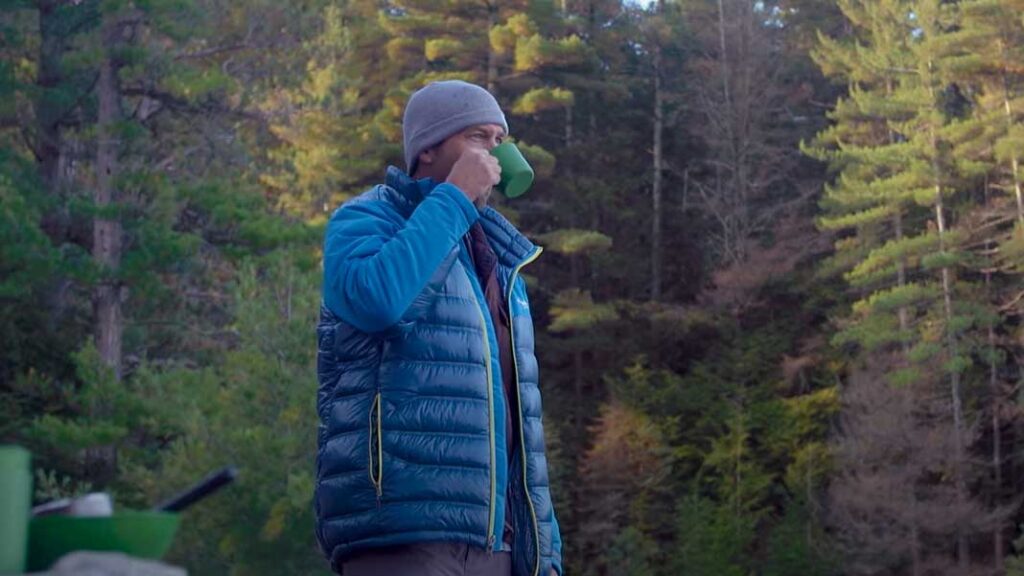
Weather is important for food planning
Another environmental factor to consider when canoe camping (as best as you can in advance) is the weather. Namely, how hot will it be? This will determine the shelf-life of different foods. If it's a scorching hot summer trip, then maybe scale back on the packaged meats. But if it's a cooler area or time of year, then you can get away with a lot more.
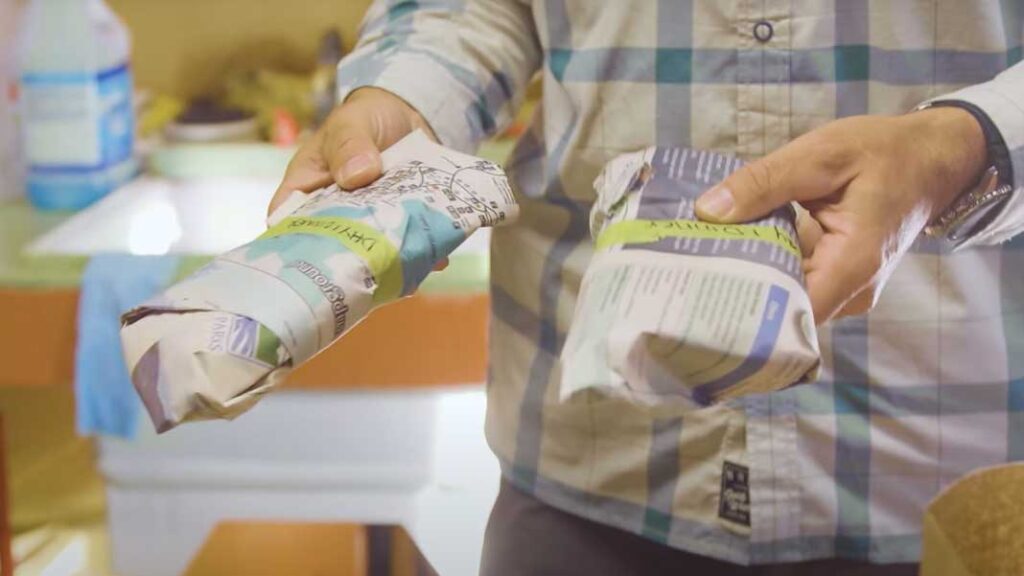
As a general rule, I like to pack more fresh foods for the first 2 days, and then I'll switch over to pre-packaged and dehydrated stuff, just to be on the safe side.
Calories you burn on a multi-day canoe trip
And a final thing to consider is how many calories you and your crew expect to burn. Is this a poke along and smell the roses kind of affair, or is it an ambitious, cover a lot of ground type deal?
In the case of my reference 5-day canoe trip, my buddy and I planned to do a lot of hard paddling, in cold and windy conditions, while also banging out several challenging portages.
4000 calories a day per person
Taking all of this into consideration, we determined that we would need about 4,000 calories per day per person.
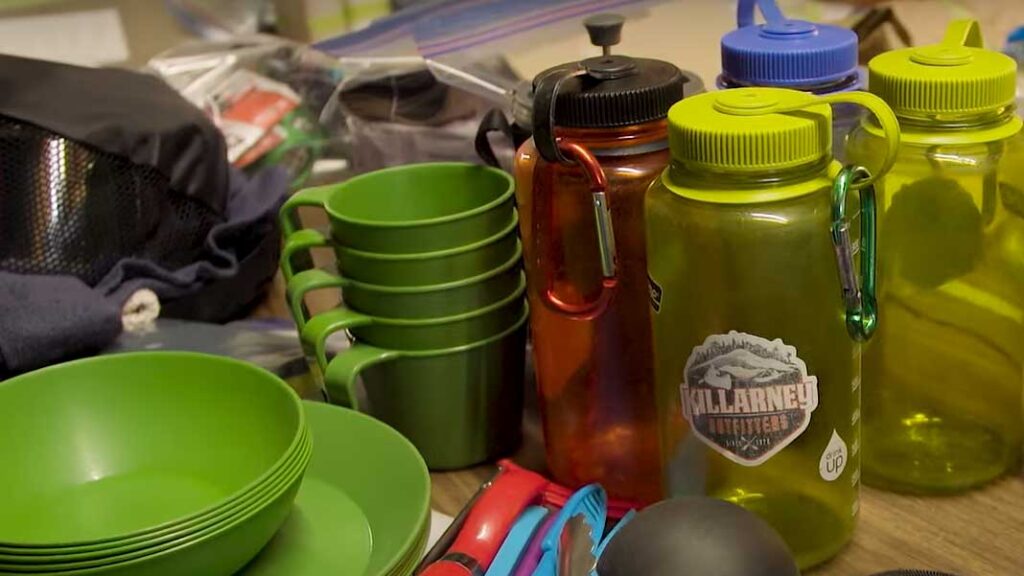
What should I eat on a canoe camping trip?
Now that we've covered some general considerations, let's dive into a 5-day sample meal plan. For this trip, our campsites all included firepits with those built-in grill grates, and so we planned to do a lot of our cooking over open flame (particularly in the evening). But we also packed lots of fuel for our classic camping stoves.
Meal Plan for Canoe Camping Day 1
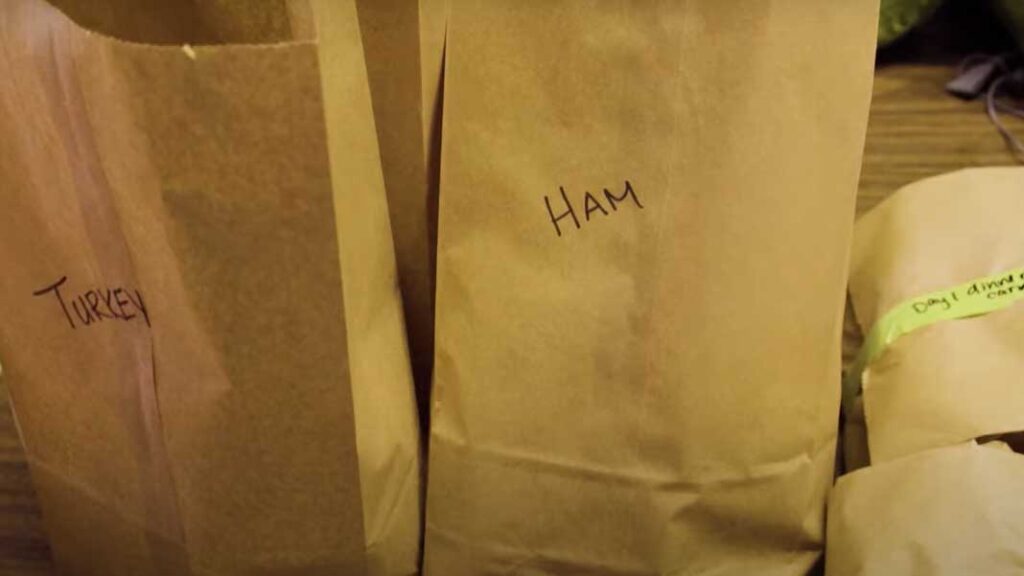
Breakfast : Consumed on shore before pushing off
Lunch : Pre-made sandwiches, chips, and a piece of fruit (classic school lunch)
Dinner : 4 frozen/wrapped steaks, baked potatoes, and mushrooms
Meal Plan for Canoe Camping Day 2
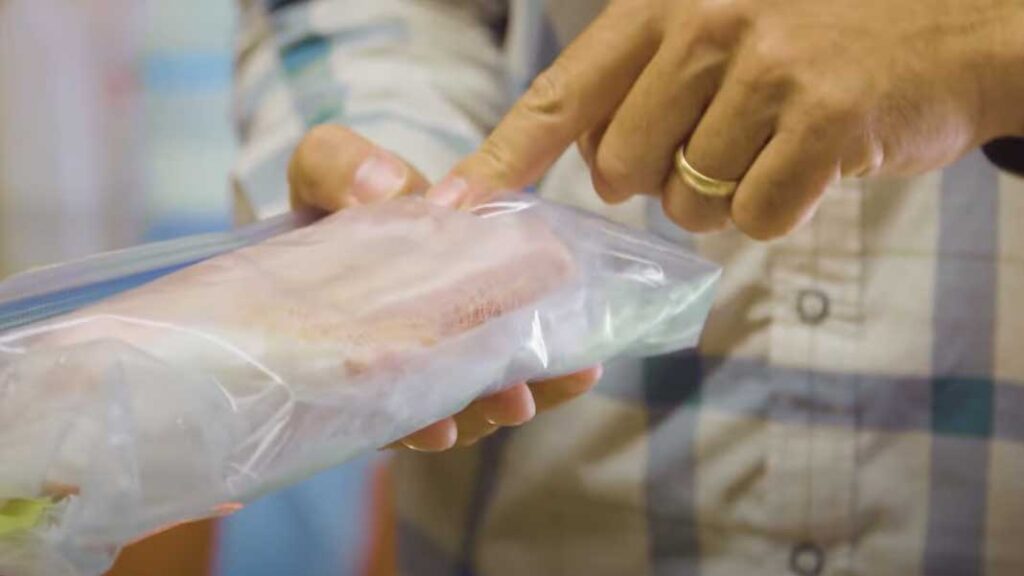
Breakfast : Bacon (wrapped in vinegar-soaked cheesecloth for preservation purposes), eggs (see note below), and fresh bread
Lunch : “Trail lunch” for anticipated portages (i.e. trail mix, cheese/crackers, granola bars, beef jerky, peanut butter/jam).
Dinner : Frozen beef chili sealed in Ziploc bags and wrapped in newspaper
Meal Plan for Canoe Camping Day 3
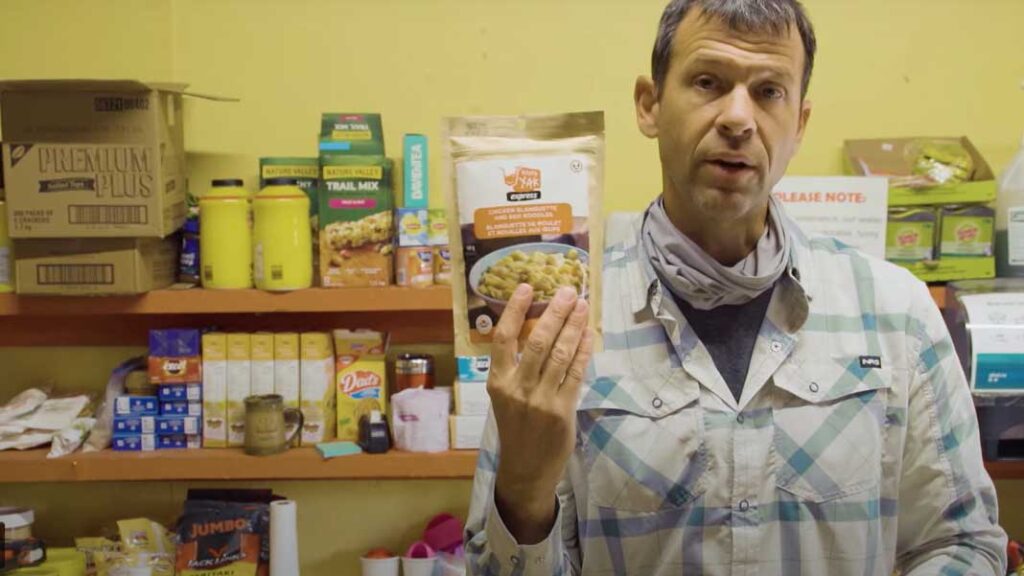
Breakfast : Instant oatmeal w/ dried fruit (raisins, blueberries, banana chips, etc.)
Lunch : Salami and cheese tortilla wraps (meat and cheese also wrapped in vinegar-soaked cheesecloth) + celery/carrots
Dinner : Dehydrated mac and cheese
Note: Although many camping meals say they are good for 2 people, in reality, after a day of hard paddling or trekking, most people seem to like a full package to themselves.
Meal Plan for Canoe Camping Day 4
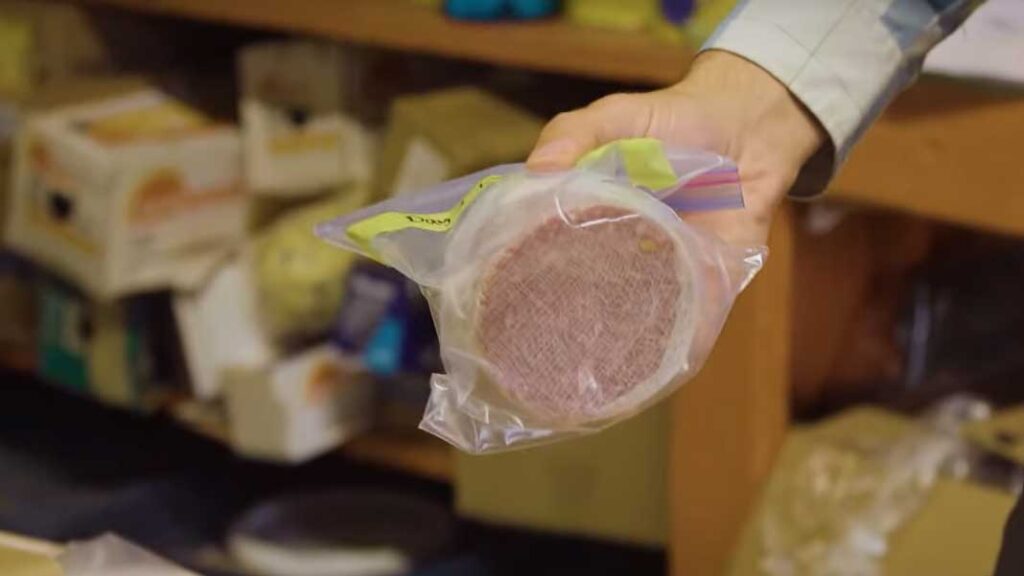
Breakfast : Instant oatmeal w/ dried fruit
Lunch: Salami and cheese but this time on pita bread rather than tortillas + celery/carrots
Dinner: Dehydrated pad thai
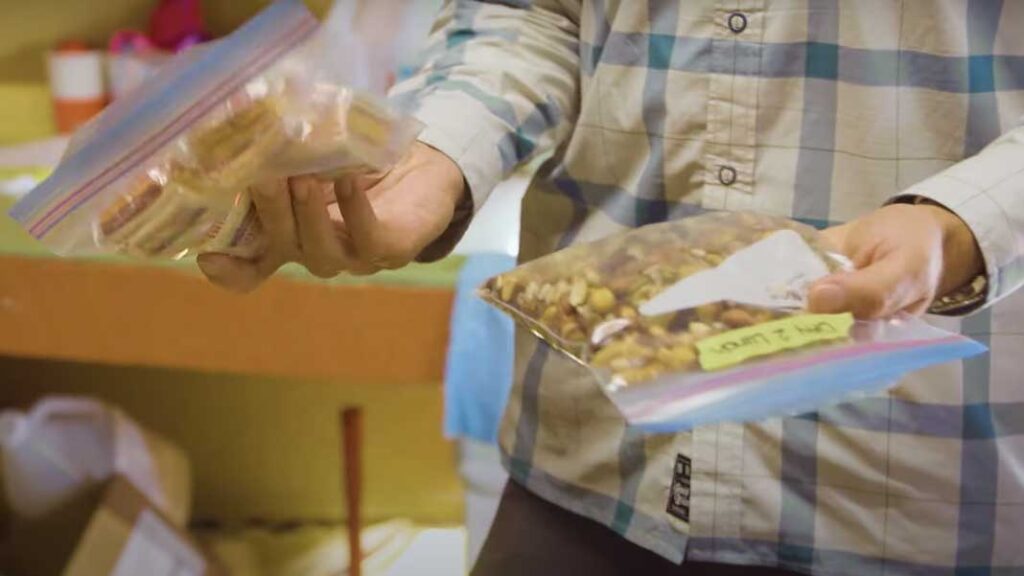
Meal Plan for Canoe Camping Day 5
Breakfast: Instant oatmeal w/ dried fruit
Lunch: Same as day 4
Dinner: Dehydrated meal (whatever flavor is left after the group picks them over for 3 nights)
Extra Snacks throughout the trip:
Trail mix, cookies, brownies, fresh fruit (for the first few days), pepperettes, popcorn, tea/coffee
Can you bring eggs on a canoe trip?
You may have noticed my inclusion of eggs in the meal plan and wondered if that's ok to do. Eggs are a great source of protein, and they're super easy to cook up, so I love bringing them along.
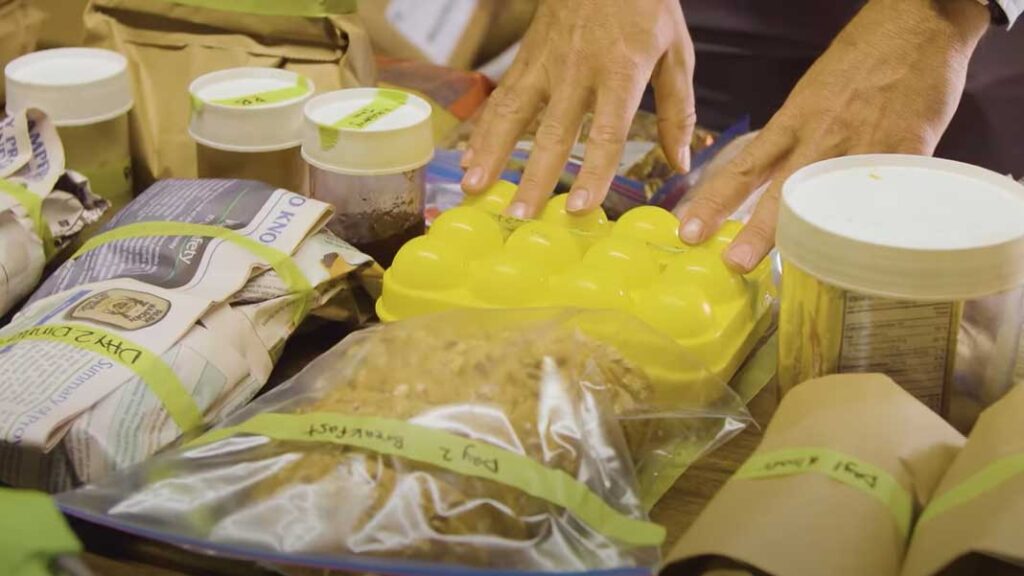
The trick is keeping them protected, which can be done by getting one of those hard plastic egg cartons that you can find in any home/kitchen section of a big box store.
Our friends at Killarney Outfitters also blanched our eggs in advance, meaning they briefly dropped them in boiling water in order to kill all the bacteria on the shells. This helps extend the shelflife out in the wild.
Shout out to Killarney Outfitters!
All of these tasty and strategically planned meals during our canoe camping trip were laid out for us by Killarney Outfitters . I love working with them anytime I'm in the area, and since Killarney Provincial Park is one of my favorite places to paddle, we've gotten to know each other rather well over the years. They are so well-stocked and familiar with the area that you can essentially just show up with a toothbrush and a change of underwear, and they'll fix you up with the rest.
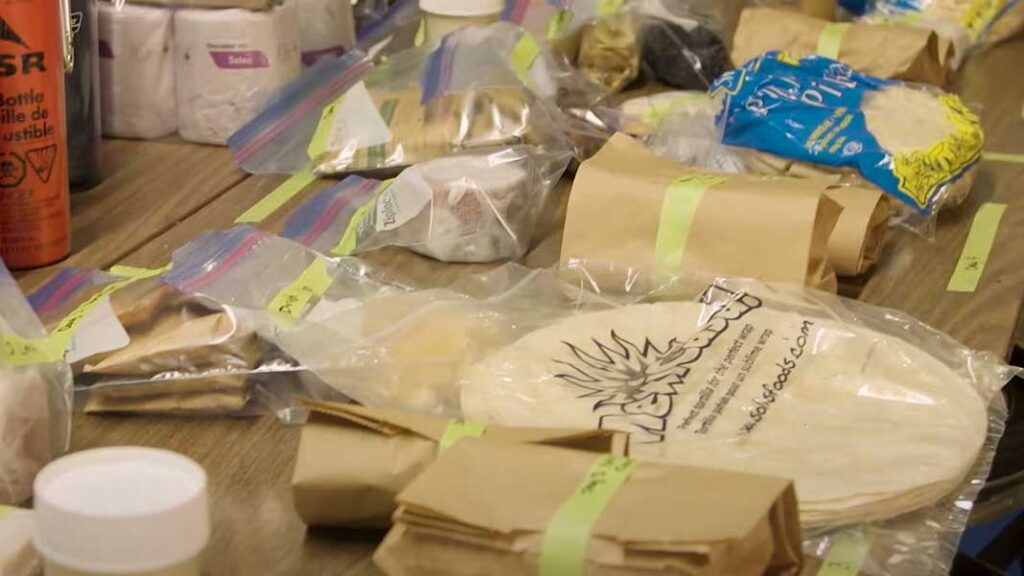
I hope all this talk of camping food has you chomping at the bit for your next canoe trip. Each person and each excursion is a little different, but this should give you some idea of what to pack, and what to skip over. For more paddling tips, gear reviews, and to share in the adventures, make sure to follow along with PaddleTV and subscribe to the In4Adventure newsletter .
- canoe camping
- canoe trips
- meal planning
Related Articles
Comparing cotopaxi travel bags: guide for adventurers, pain-free backpacking: strengthen your posterior chain, day hiking packing tips, our paddling community, ken whiting: paddling.
More Reviews
P&h scorpio sea kayak review, ultimate guide to choosing the right kayak, dumoine river in quebec | best 7 day river trip (i missed), california coastal kayaking, sea eagle 300x inflatable kayak review.
MY GLOBAL PARTNERS! Special thanks to my Global Partners for supporting my mission of helping get people on the water and creating life-long outdoor participants.

Backcountry Canoe Camping: A Meal Planning Guide

There is nothing quite like a backcountry portage camping trip to experience the beauty of Canada and its vast expanse of lakes and tiny islands. If you have never been portaging before, you may have some questions about what and how to eat. Unlike a car camping or cottage trip (where you could “wing it” if you had to), it is worth your while in a backcountry scenario to put some careful thought into your meal planning in order to maximize enjoyment and safety. I’m drawing on two decades of camping experience to summarize some of the important things I learned along the way!
Pre-Planning
Start by brainstorming with your camping group without restriction. Throw out ideas for breakfasts, lunches, dinners, desserts and snacks based on what you like eating and know how to prepare (under normal circumstances), while making sure to cover your proteins, carbs and fats. You will need substantial, nutritious meals to keep up with a higher level of physical activity than you would on a regular day at your office job.
Next, slot the best brainstormed meal ideas into a draft table/schedule. Make a column for each day of your trip and allocate room for three meals, one dessert and two official snacks on each day, along with an indication of daily water supply required (and where it will come from). Make space for other beverage allocations (juice, coffee, tea and alcohol if you fancy) too.
Make a note under each daily column of the location you plan to be, the distance you plan to cover, and the environment you will be in (ie. Will you have access to a campfire? Is your fresh water source guaranteed? What are the expected weather conditions?). This will give you a clear picture of the kind of foods that might work best for each day.
Technical Planning
Once you have a general idea of what you want to eat, it’s time to make sure that your food brainstorm list aligns with reality. All of your meals should take into consideration:
- Perishability and Food Safety: Each group should bring at least one small cooler, but it’s still important to focus on food that can be stored at room temperature because your ice always melts faster than the trip lasts. If you enjoy dairy and meat, consider adding drier or wax-covered cheeses (think Parmigiano Reggiano or Babybel) and cured meats to your mix. If you want to bring fresher dairy, meat or seafood, plan to eat those items on day 1 and 2. Tip: freeze the fresh proteins you plan to eat on the second day, along with any beverages you intend on bringing and use them as temporary ice packs as well.
- Weight: Even though a canoe is a great way to move heavier things around, don’t forget that you will also have to carry all of your food and gear in and out of the canoe at every juncture, not to mention, the canoe itself! It’s best to keep things as light and compact as possible. Consider whether there are some food items that could be dehydrated or freeze-dried. Consider whether some items can be pre-cut or prepared in advance (ie. shucking your corn, dicing carrots). And finally, consider whether there is anything you can repackage better yourself (eliminate awkward boxes and put items in Ziploc bags instead).
- Cooking Time and Effort: How much patience do you have to cook your food and how much fuel and equipment do you actually want to carry? Do not overestimate your abilities, or underestimate your fatigue after a long day out on the water and in the woods. More importantly, the weather is always unpredictable, so don’t ever assume you will be able to make a roaring campfire every night. Keep things easy, and keep things flexible.
After analyzing your brainstormed list against the considerations above, make all necessary adjustments and swaps. Do a final scan and make sure everyone’s allergies and dietary restrictions have been accounted for.
Divide and Conquer
Once the menu is set, it’s time to make your detailed grocery list. If more than one person will be shopping, make a master list, and then sub lists for each person who will be tasked with purchasing and preparing items. This is extremely important to make sure common items (oil, seasonings, herbs etc.) are accounted for, while also ensuring they are not unnecessarily duplicated.
You will also need to shop with the final packing in mind. For a group of 4 campers, I would suggest one dry bag per canoe, with the more experienced canoe also taking on the responsibility of the cooler. If the two pairs will be meeting up at the departure point, do a quick inventory then and make your packing adjustments before embarking on the trip. Don’t forget to bring at least one strong, long rope per dry bag so that you can pack your food away and hang it in a tree to keep the bears at bay.
In terms of quantity, you should strategically aim to have at least 30% more food than what you would normally eat at home. Not only will you be burning more calories, but you’ll want a little buffer in case something in your food supply goes bad, or something unexpected happens that causes you to get lost or separated from the rest of your party. This is another reason why you should always split the food between two or more canoes.
Non-Food Food Packing List
- One plate, mug and bowl per person
- A reusable water bottle ( wide-mouth Nalgene bottles are excellent for hot and cold, measuring, and can also work as a hot water bottle to place in your sleeping bag if it gets really cold)
- Personal camping utensils (roll up in a dish cloth ideally to prevent puncturing anything)
- A cutting knife, a can opener (if necessary), a deep spatula that could also double as a ladle (also wrap up these items up carefully in a dish cloth)
- A small cutting board
- A set of nesting pots (two is ideal) with a pot gripper and at least one lid
- A small camp burner stove with enough propane to last the trip
- A foldable grill (but check if your site will already have built-in grills on firepits)
- Aluminum foil (can be used for all sorts of cooking methods, including making a makeshift pan, wrapping leftovers, and throwing anything whole (like a potato) directly into a fire without a grill)
- Two disposable lighters and/or flint with fire starter (if allowed at your site)
- Coffee maker with coffee (have you tried the Aeropress ?) or instant coffee and/or tea
- A personal Swiss army knife is always a good idea
- Water purifier (extremely important)
- Environmentally-friendly dishwashing soap ( Campsuds are what I use; note that it is extremely concentrated!) with a scrubber
- a few Ziploc bags and sturdy garbage bags
Sample Menu for a 4-Day Trip
- Breakfast: at home or on the road
- Lunch: at the Meeting Point or Outfitters (but pack some hearty snacks in case food is not available)
- Snack: Protein snack bar ( Rx Bars are my current favourites)
- Dinner: pre-marinated chicken skewers with Greek seasoning, zucchini, red pepper and red onion (make sure skewers do not puncture your bag by wrapping in foil and then in a bag, sand down the skewer points), Tzatziki sauce and pre-made rice pilaf.
- Dessert: Banana Boats (slice open bananas lengthwise, add toppings like chocolate chips, marshmallows, etc, wrap in foil and throw into campfire).
- Breakfast: French Toast Sticks (bread, milk, egg and cinnamon mixture (can make beforehand)) with strawberries, blueberries and maple syrup
- Snack: Mandarin oranges
- Lunch: Croque Monsieur sandwiches (Paris ham and Gruyère cheese and Dijon mustard, grilled if you like, or cold if you’re heading out), Romaine lettuce salad
- Snack: Homemade trial mix
- Dinner: Polish Sausage or Bratwurst Hot Dogs with grilled red bell peppers, onions, mustard, mayo and/or ketchup (cook on campfire or camp stove), pickles, potato chips
- Dessert: Classic S’mores
- Breakfast: Crispbread with Laughing Cow Cream Cheese or Babybel, tomato and cucumber, salt and pepper
- Snack: Apples
- Lunch: Veggie chickpea curry wraps
- Snack: Homemade beef jerky
- Dinner: Burritos with dehydrated (and rehydrated) beef or veggie ground, beans, peppers, onions, rice, seasoning, guacamole (fresh avocados and cilantro, pre-made guacamole mix) and crackers
- Dessert: Campfire Apple Crisp (but made in the small pot and finished in foil in the fire)
- Breakfast: Instant oatmeal packets with additional dried fruits and nuts (cranberries and almonds are my favourites)
- Snack: Carrots and hummus
- Lunch: Peanut butter, jelly and banana sandwiches on the go
There you have it! Special thanks to all my friends and family who I’ve camped with who I have taken inspiration from (especially frequent portage buddies Mike and Dennis) for some of these food ideas. Happy camp meal planning!
Pin for later:
Leave a Reply Cancel reply
Your email address will not be published. Required fields are marked *

IMAGES
VIDEO
COMMENTS
Level up your canoe camping meals with these easy but delicious canoe trip recipes, like curry, cinnamon buns, cake, chilli and more!
Curious about packing food for canoe camping trips? Are you looking to transition from day paddles to overnight trips? Whether you are an experienced paddler looking to improve your nutrition or just curious about what canoe camping is all about, this article is for you!
Here are some of the best canoe trip meals and snacks that are quick to prepare and and lightweight to carry. Peanut butter and jam/jelly wraps Instant oatmeal packets – good canoe trip breakfast option
Food & drinks. There’s nothing like a good meal after a long day on the water. Depending on the length of your trip and how much you can bring, pack accordingly. Calories, protein, goodies, oh my. Meals: Create a meal plan for your canoe trip. Search for recipes or buy pre-packaged dehydrated meals.
Canoe trip meals should be easy to prepare, delicious, and provide enough energy for your paddling adventures. Whether it’s breakfast, lunch, or dinner, having a variety of canoe camping recipes in your arsenal ensures that you and your companions can enjoy good food throughout your journey.
There are three basic options when it comes to meals for your wilderness canoe trip: “real” food (non-dehydrated), pre-packaged dehydrated meals marketed to backpackers, and DIY dehydrated meals. There are pros and cons to each of these: Bring “Real” Food. PROS: Tastes great • healthy • budget-friendly
Good food is part of a fulfilling canoing experience! Here are some of our favorite canoe camping meals that are easy to make and delicious to eat.
If your goal is to cover distance but take your time doing it, your meals can get a bit more creative. Because there are numerous resources about packing light food for backpacking, this post will focus on the creative meals you can enjoy while on a multi-day paddling adventure.
December 22, 2022. When planning for a longer canoe camping trip, I would go as far as to say that nothing is more important than food and meal planning. A boat stocked with generous supplies of delicious grub can make the difference between a fantastic outdoor experience, and one that leaves you longing for the comforts of home.
Start by brainstorming with your camping group without restriction. Throw out ideas for breakfasts, lunches, dinners, desserts and snacks based on what you like eating and know how to prepare (under normal circumstances), while making sure to cover your proteins, carbs and fats.